Reply from Erica Toogood - on Scissors, Rock, Paper
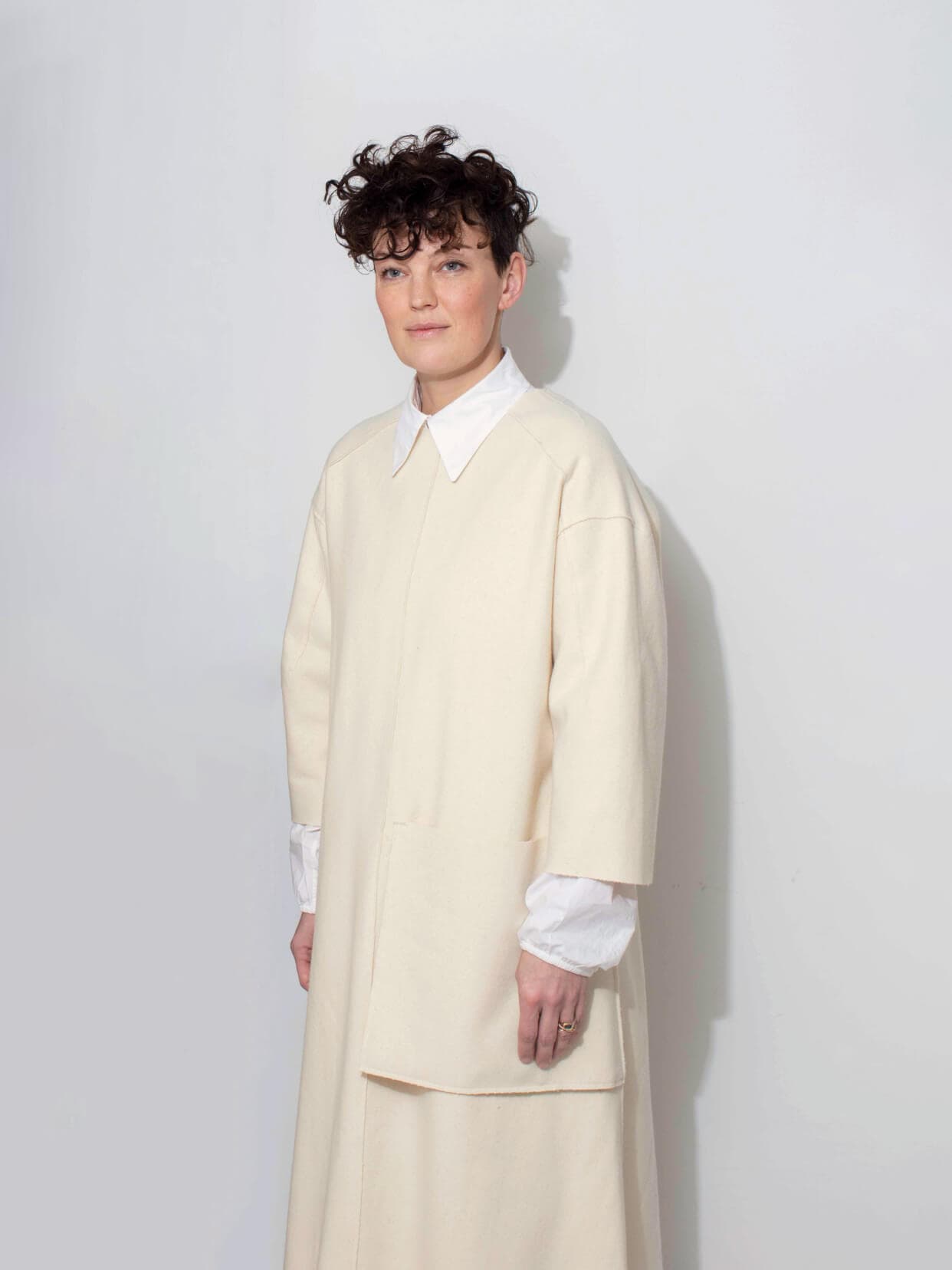
©Photography: Matthew Donaldson
Toogood's 19th clothing line is called “Scissors, Paper, Stone” (rock, paper, scissors), and the sisters are playing a guessing game. This is simple, pure joy, a tacit understanding between Faye and Erica, and the origin of Toogood's creations. In Faye's eyes, cloth is the material they cherish and carries their imaginations; scissors are Erica, creative and indispensable; rocks are a gift of nature, quiet and firm, allowing imagination to take its place throughout the entire process of making clothes, and the three are mutually reinforcing and cyclical.
In an open letter, Toogood said, “During the development of the 019 collection, we looked back to Toogood's earlier work, evoking the naivety and impulsiveness of being an ‘outsider’ at the time.” Indeed, the 019 series seems to be the end of a journey and a new beginning. Full of curiosity and questions, we couldn't help but write a letter to Toogood.
Part 1
About 019 Collection / Design
Q1
The fabrics you chose for each collection are always fascinating and unexpected. How do you usually do your pick?
Fabrics have always been a wonderful conversation between Faye and myself. With her concept building and my shape-making, the fabrication or materiality is the glue that holds both our elements together.
For collection 019 we looked back into our archive and our first three collections. It was wonderful to see how we have evolved but also to recognise the key iconic Toogood identifiers that have remained 11 years on. In the first collection we used mainly Cotton Canvas. At this early stage we didn’t know if we would sell anything so couldn’t commit to hundreds of meters of fabric. Canvas is sold by the meter, so we rubbered it, painted it, melted bin bags to it, and coated it with rot-resistant coating. This very elemental Canvas fabrication has remained close to our hearts within our collections, and today we use it as part of a garment-dye process to produce garments such as The Etcher Trouser in 019.
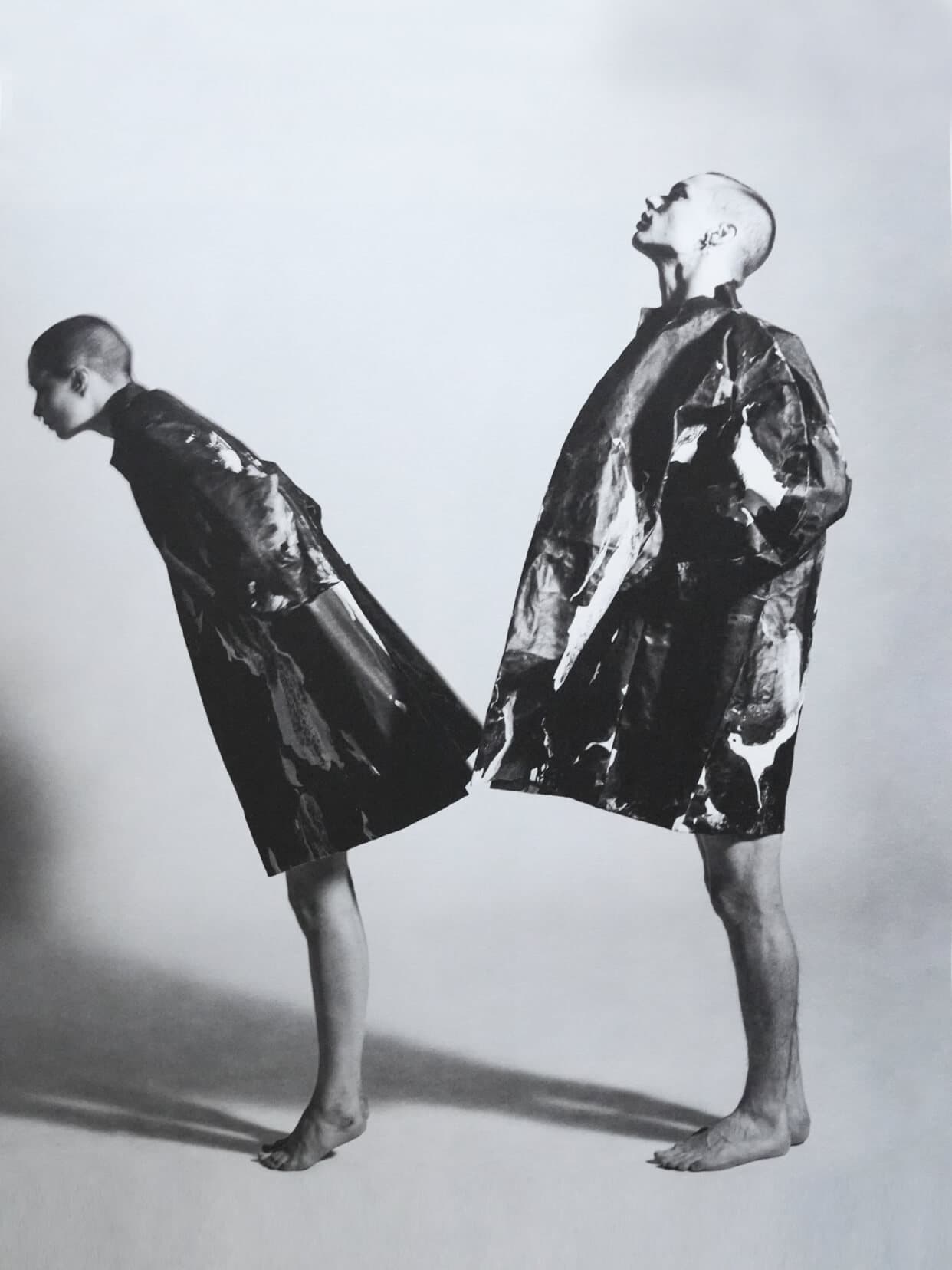
Toogood 001 Collection (2013) The Oilrigger Coat
Alongside Canvas is the ultimate work-wear fabric Denim used for The Skipper and The Engineer Jeans. It’s a robust organic denim that will ultimately soften to your shape, but also provide a sculptural fit. Wool Felt has also been a key component of all our winter collections. Used in Collection 001 and 003, we cut heavy industrial felt raw edge into our shapes to create a sculptural aesthetic that has remained at the core of Toogood’s character throughout our winter seasons. For collection 019 we sourced a Soft Wool Felt that is malleable, light and easy to wear, whilst also clearly identifying the Toogood shape with the raw edge detailing. The Coated Resin also harks back to our first collection where we sourced ‘crackled leather hide’ and cut it raw edge – they were very strong unforgiving pieces, however now we were able to source a resin coating with the bonded wool underneath to emulate the same vision, but with more lightness and practicality!
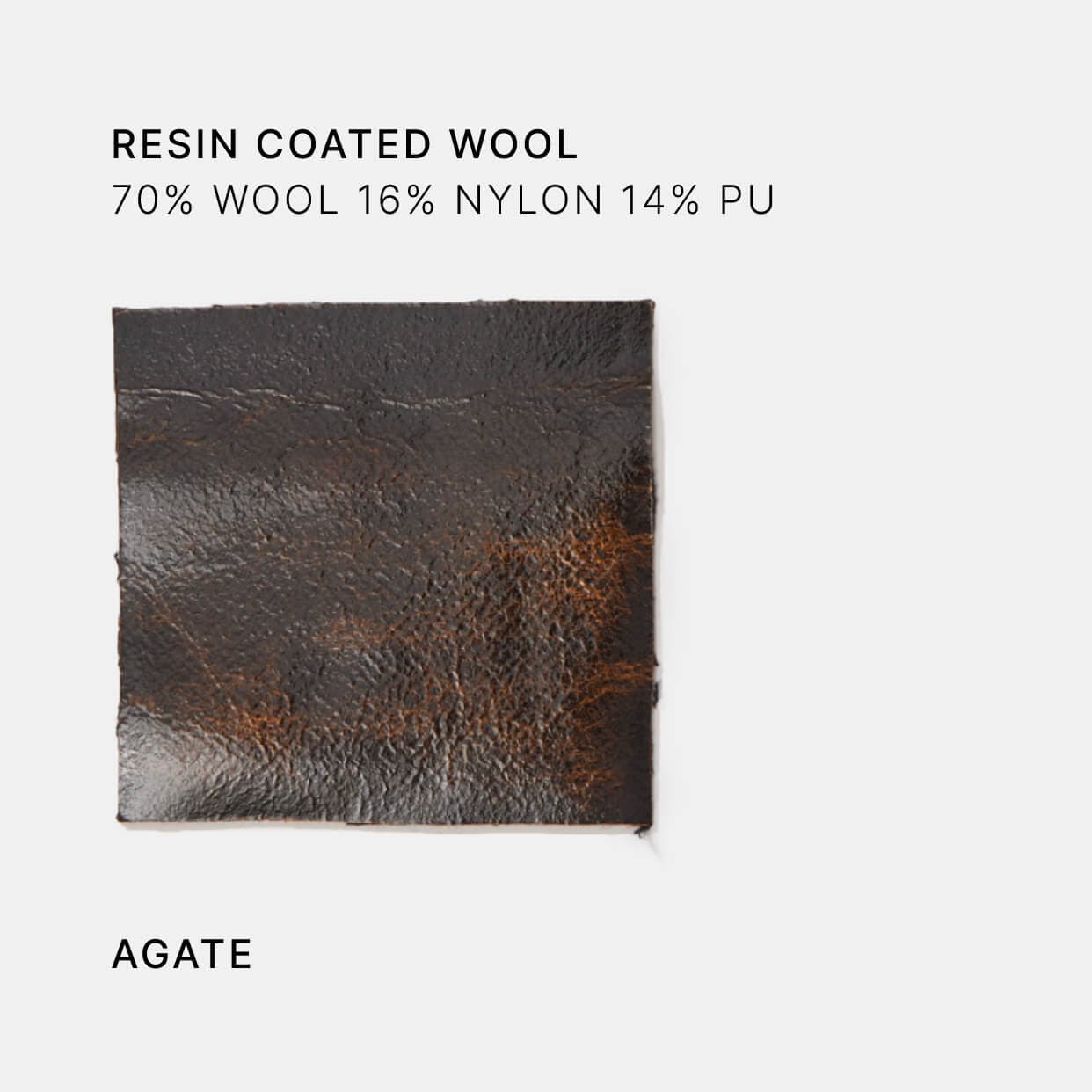
Toogood 019 Collection (2023) The Bronze Caster Gilet
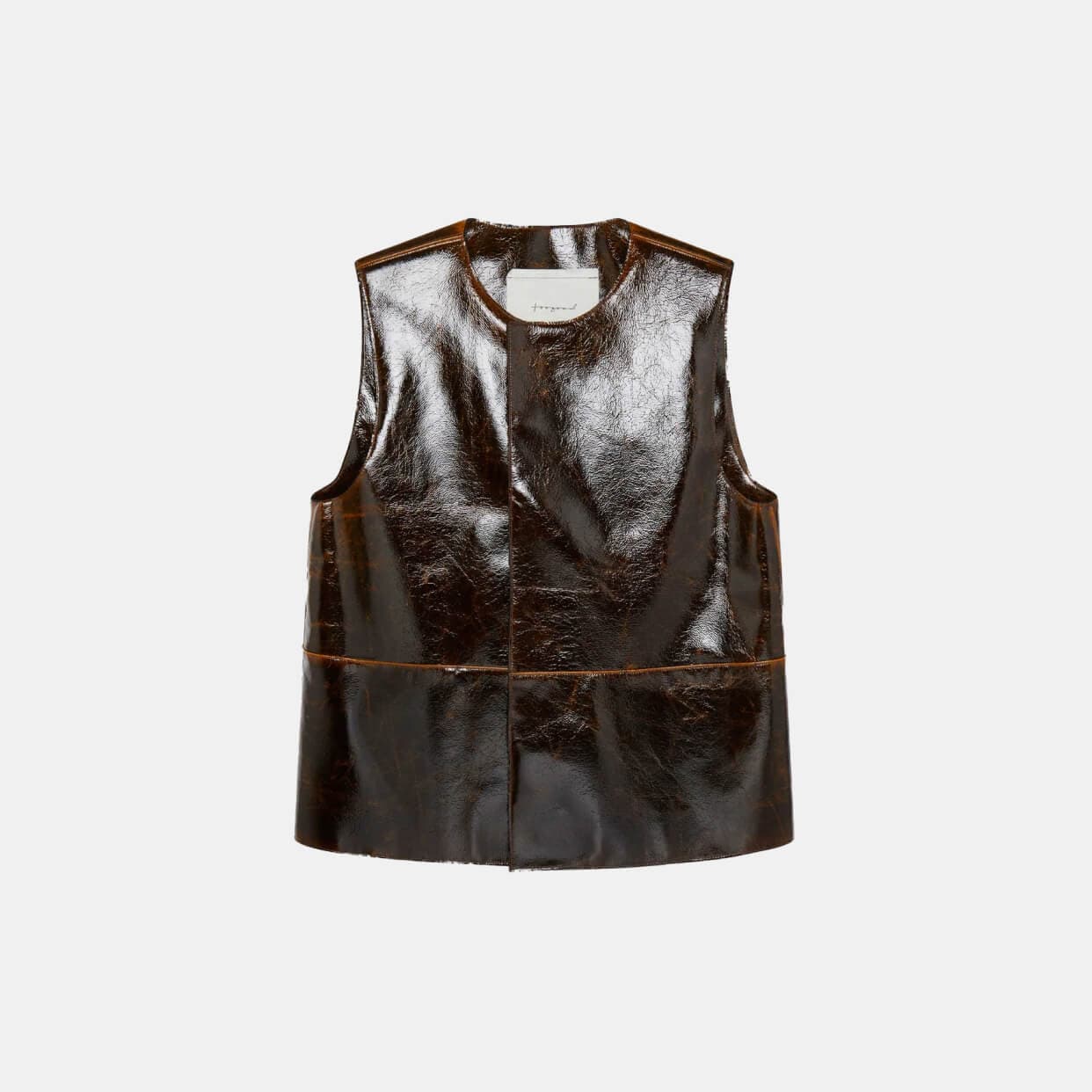
Toogood 019 Collection (2023) The Bronze Caster Gilet
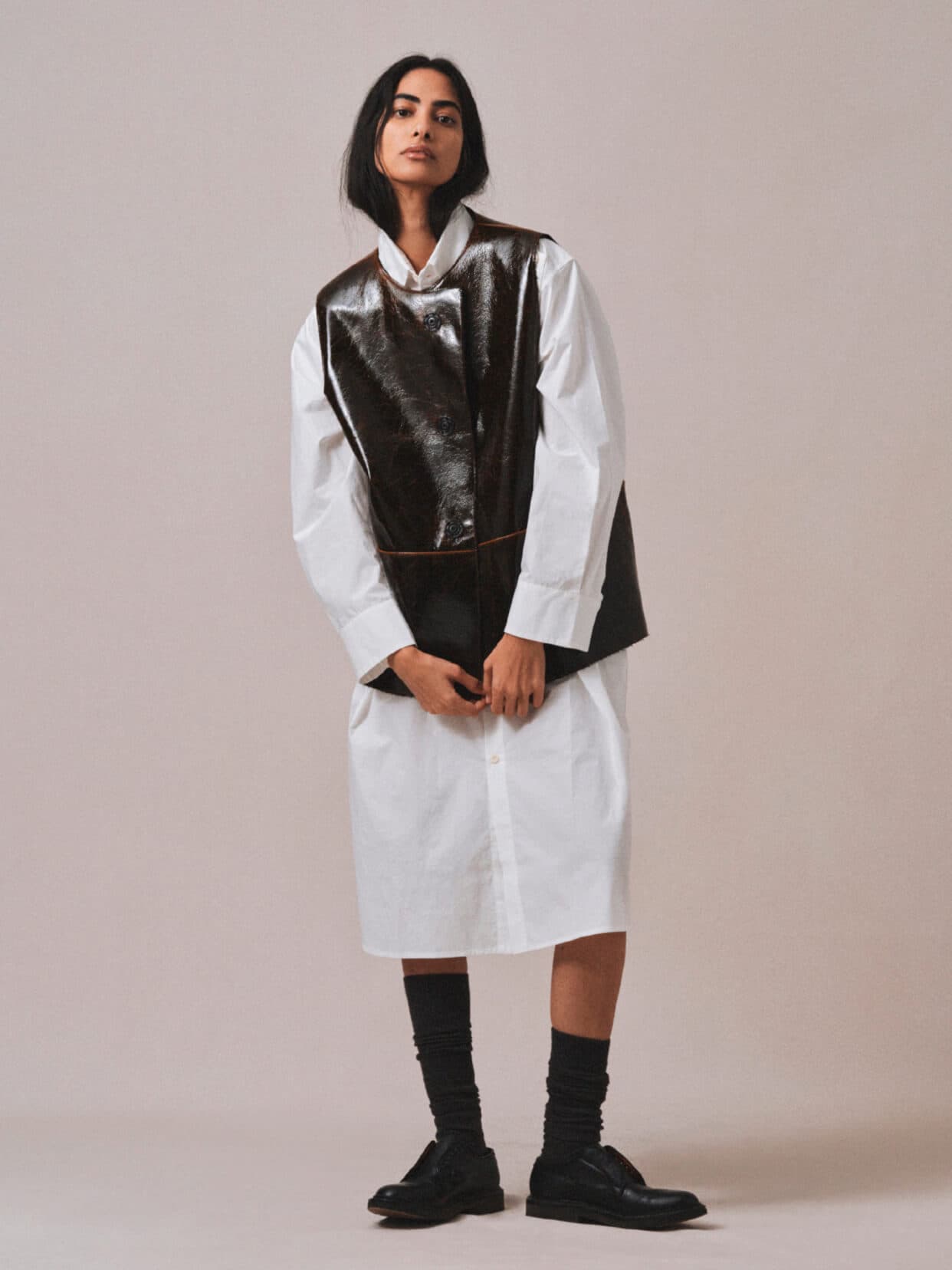
Toogood 019 Collection (2023) The Bronze Caster Gilet
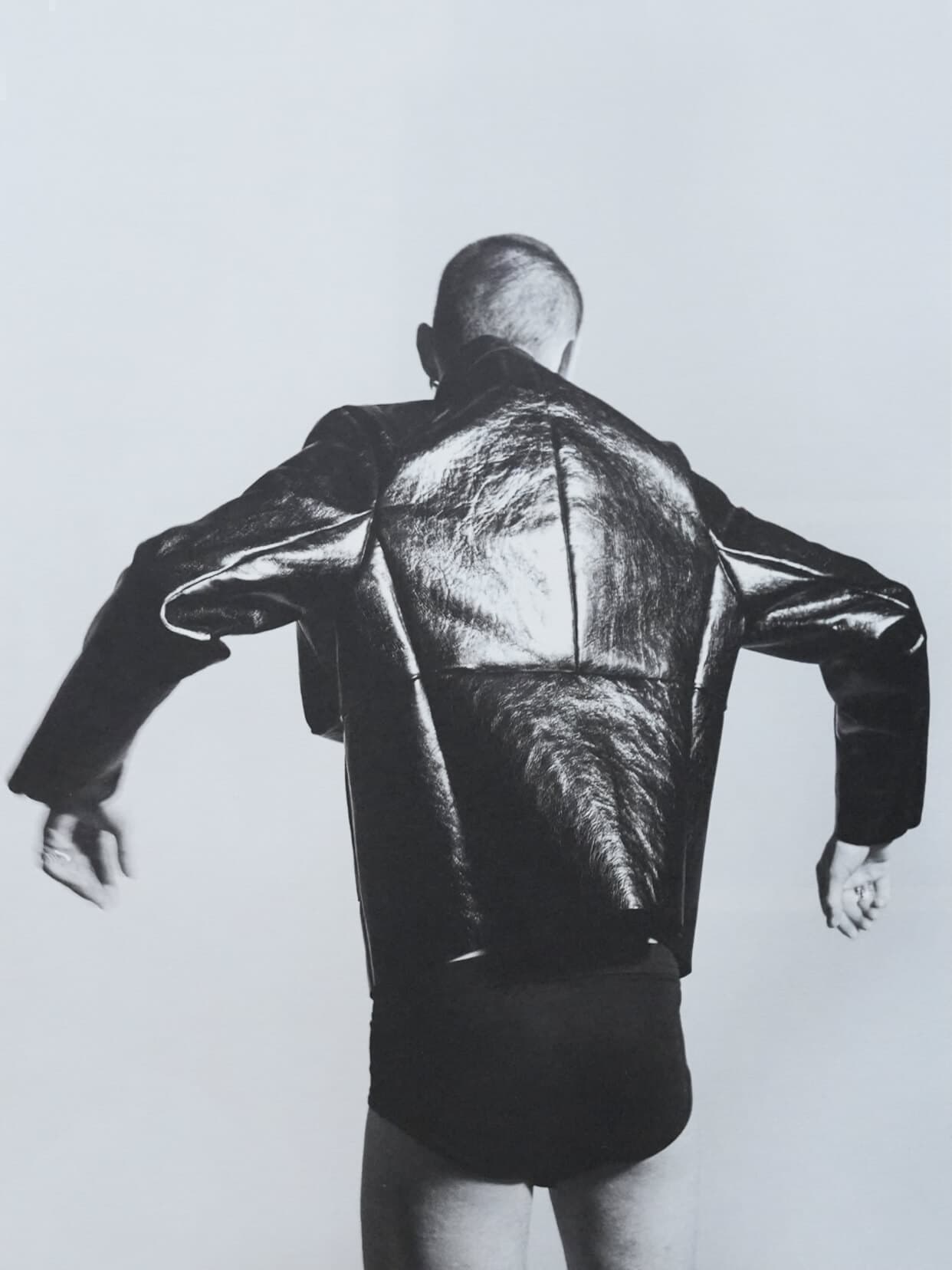
Toogood 001 Collection (2013) The Mechanic Coat
We are fortunate to work with beautiful Italian and British mills who develop textiles that can hold the character of our garments through their softness or sculptural qualities. We like to use fabrications with texture and movement, such as the Crumpled Pinstripe in The Photographer Jacket and The Printer Culotte – a crinkled cotton / wool fabric that will change over time according to your movements and shape.
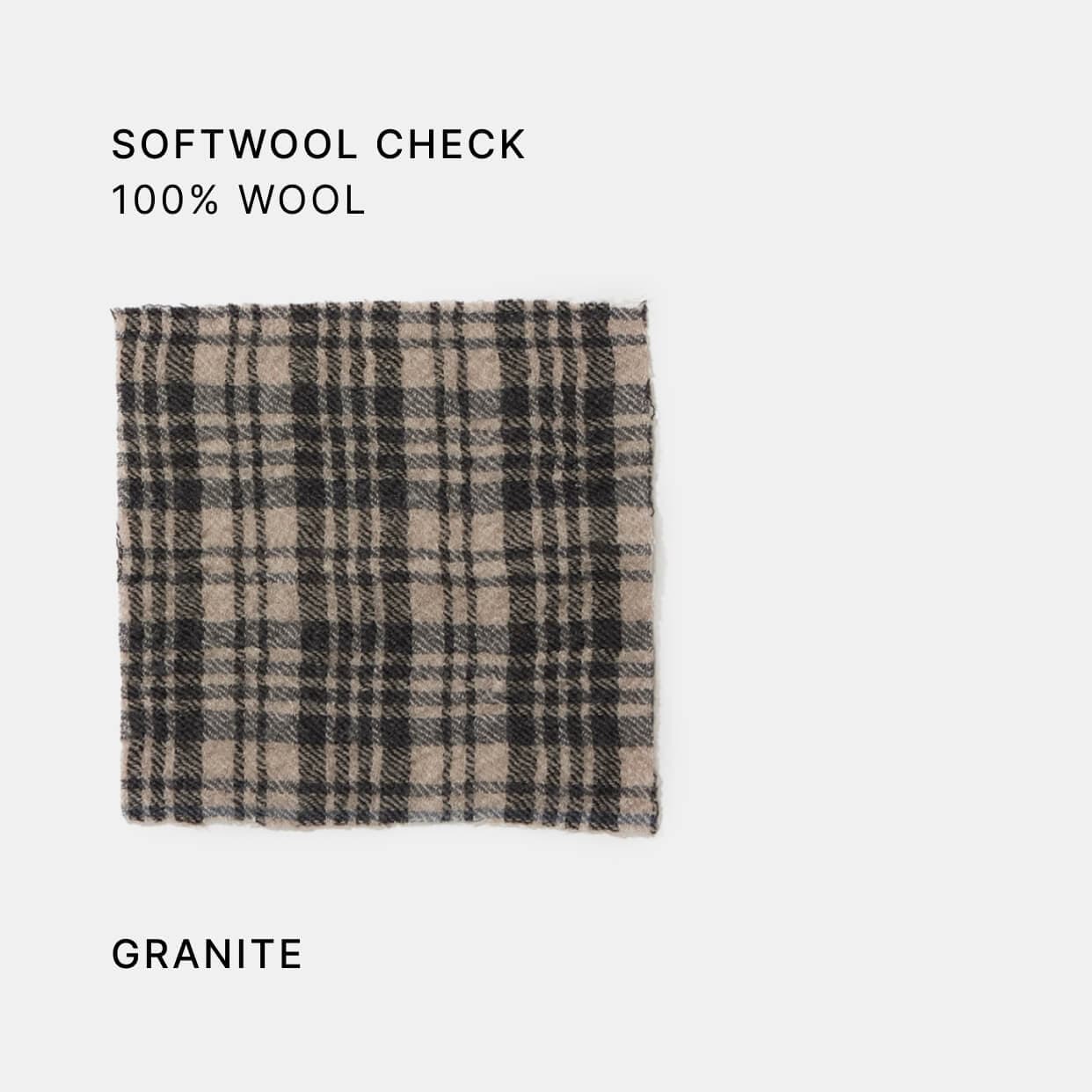
Toogood 019 Collection (2023) The Baker Trouser
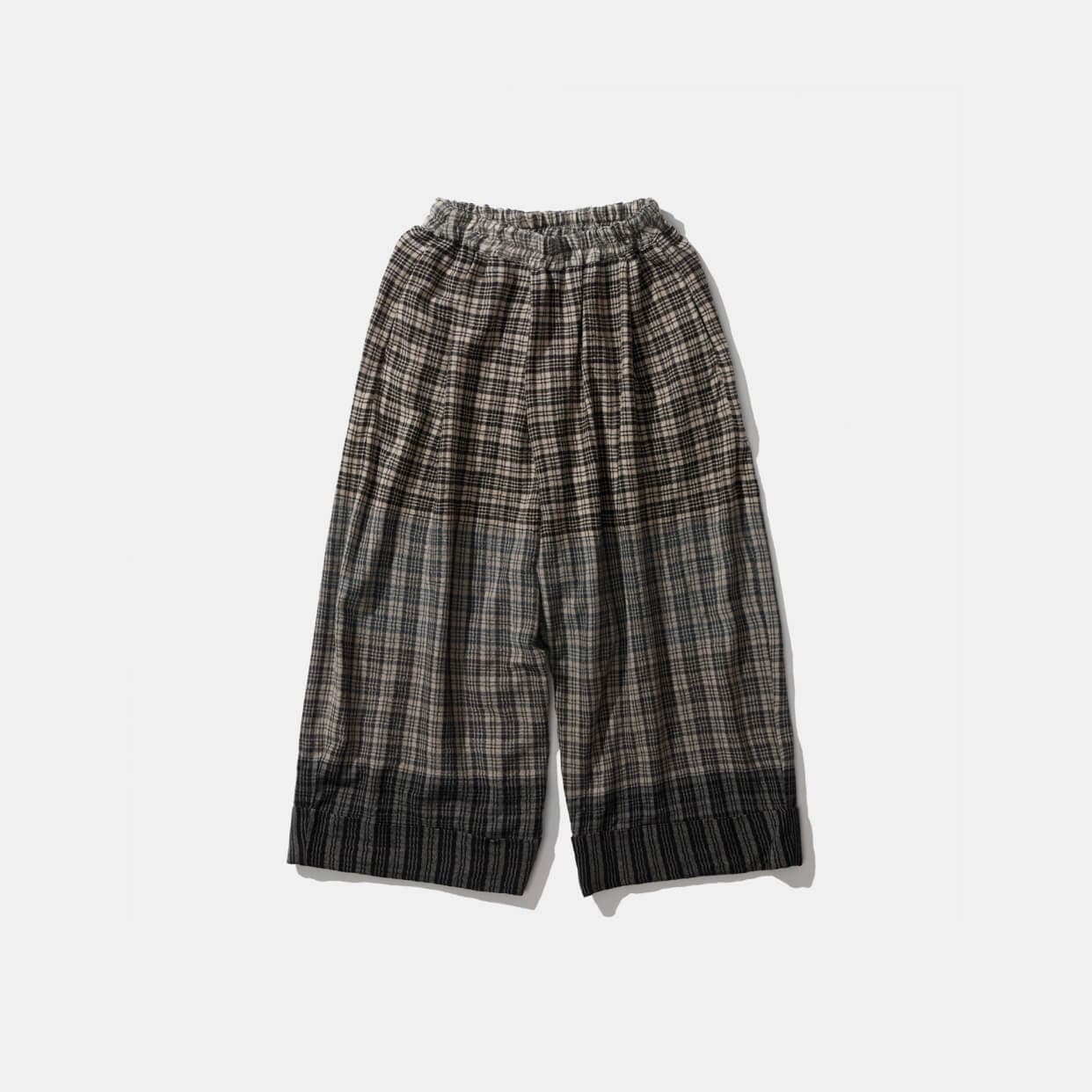
Toogood 019 Collection (2023) The Baker Trouser
This season we also worked with a beautiful light and soft wool check. The mill had woven a sample length showing the colour range possible and presented it to us to decide which yarn colours we would like to select. We chose to take the sample as it was – grading charcoals and granite colours throughout the width of the fabric - allowing us to cut the garments (for e.g. The Baker Trousers) across those colours, resulting in a colour graded garment which is very appealing.
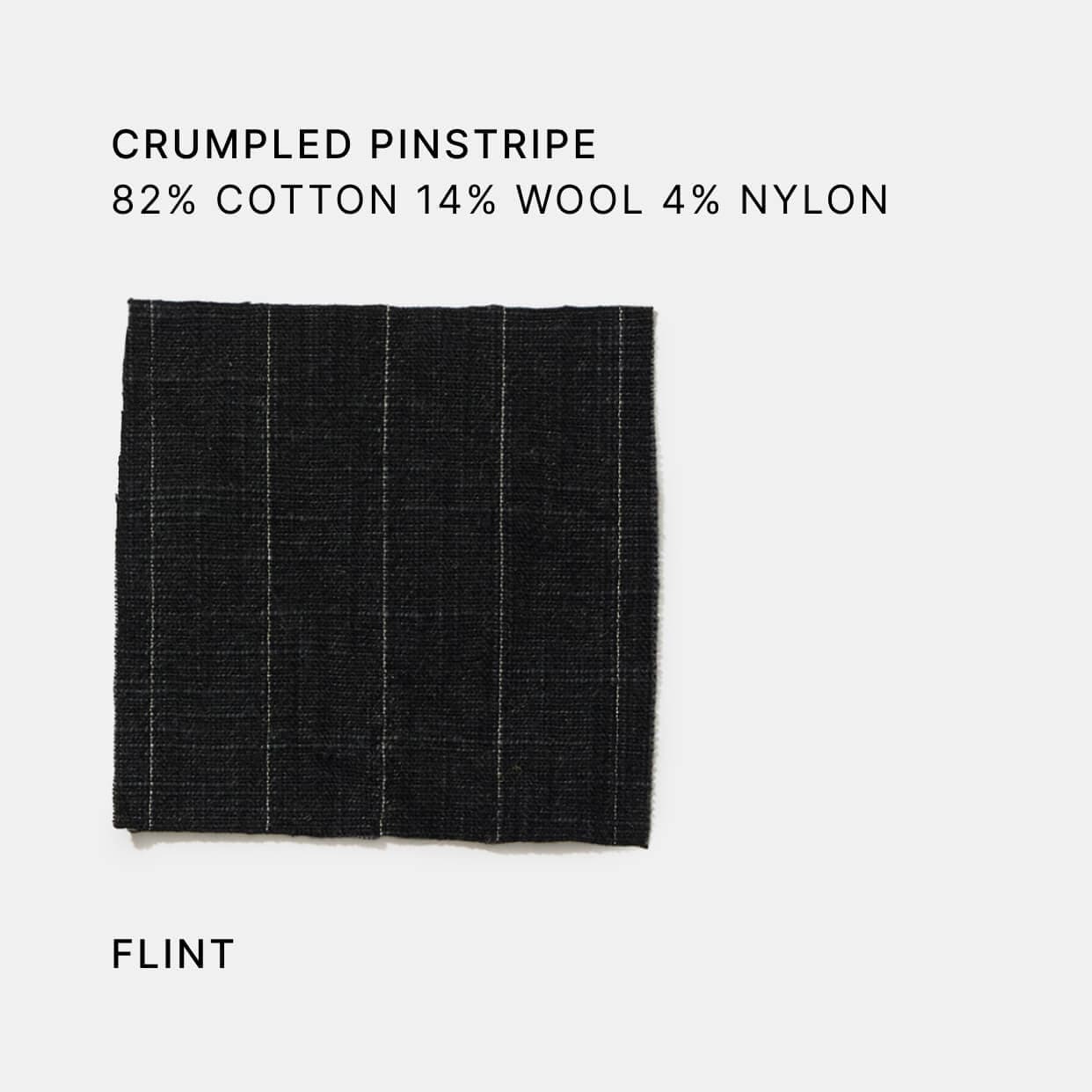
Toogood 019 Collection The Printer Culotte
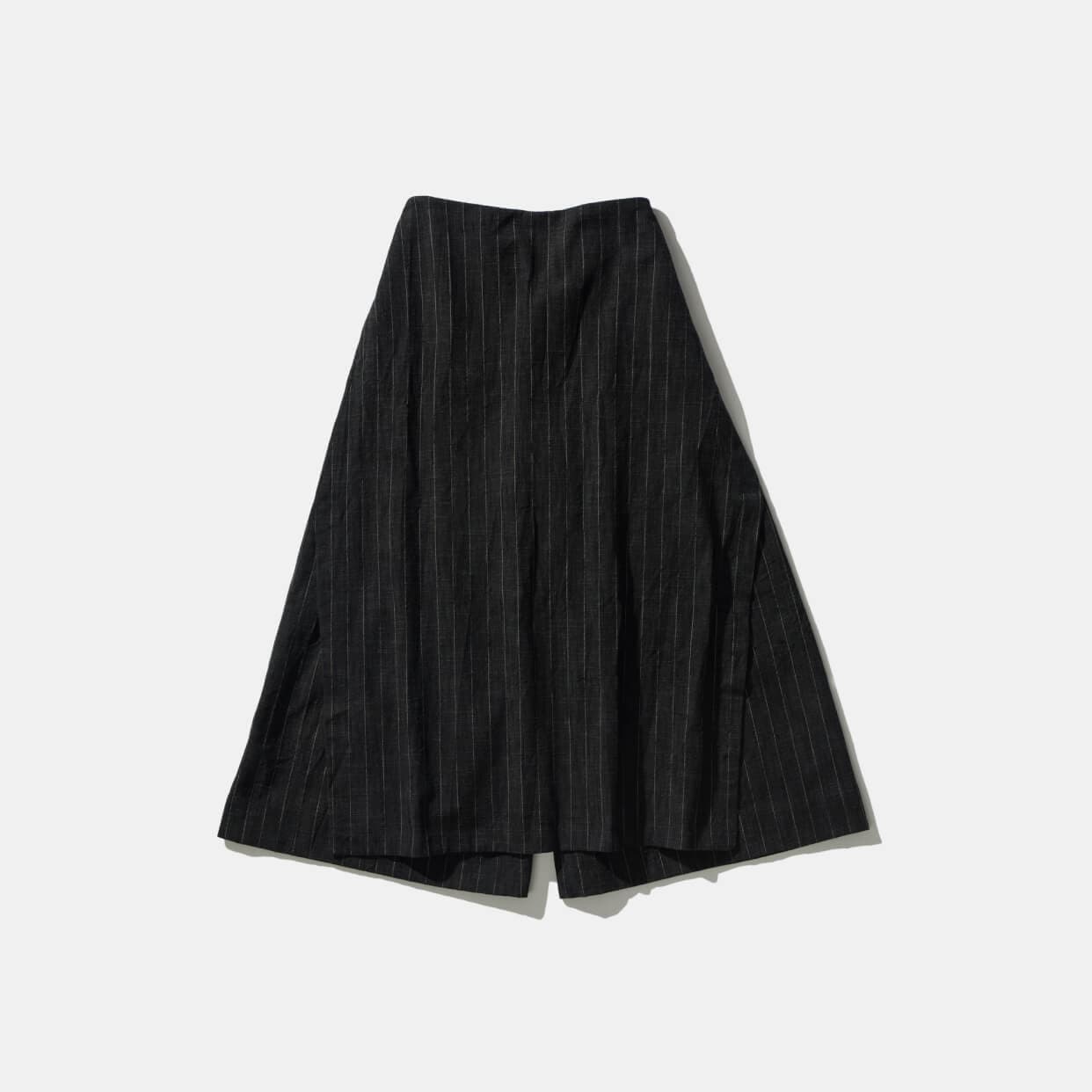
Toogood 019 Collection The Printer Culotte
The Hand-knitted Mountaineer pieces (hats, scarves and jumpers) are made from a thick, robust 100% wool. In Collection 003, we made alpaca handknit pieces with our mother. She made all the samples, and then made all the production. She was knitting for months, and thoroughly enjoyed it, although it covered her house in yarn! Now we work with a team of female Knitters in Romania, who sit and hand knit every piece – it’s a very special process.
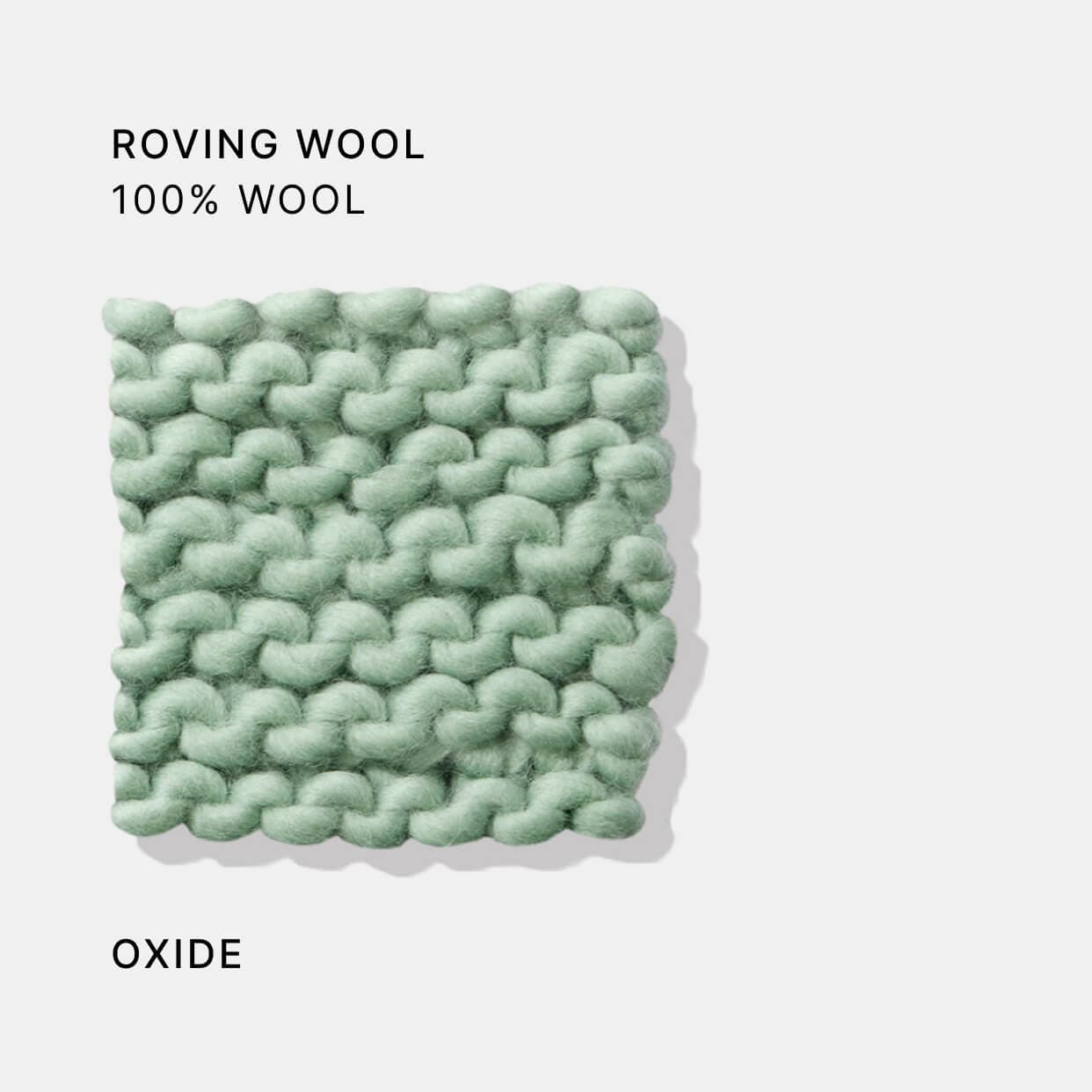
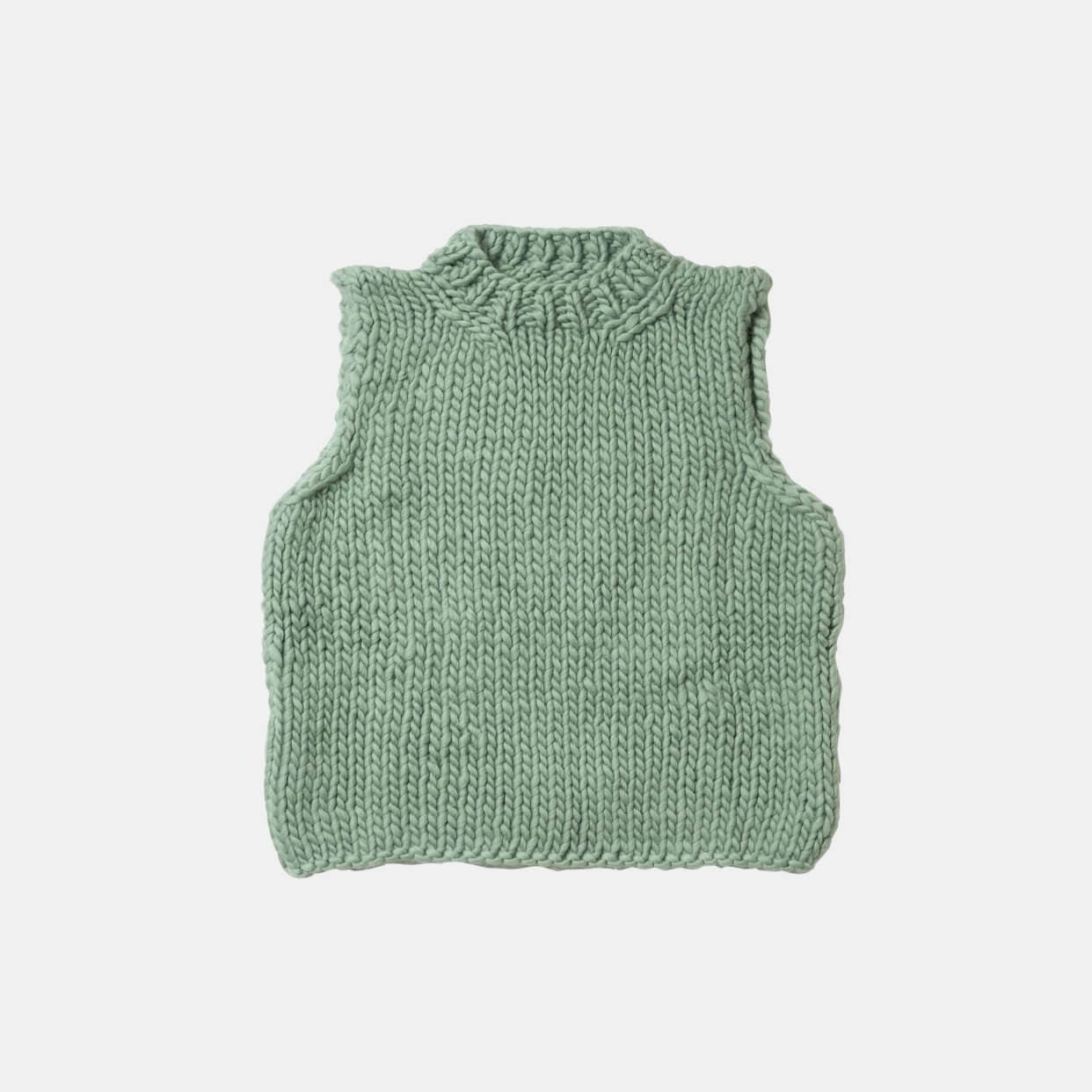
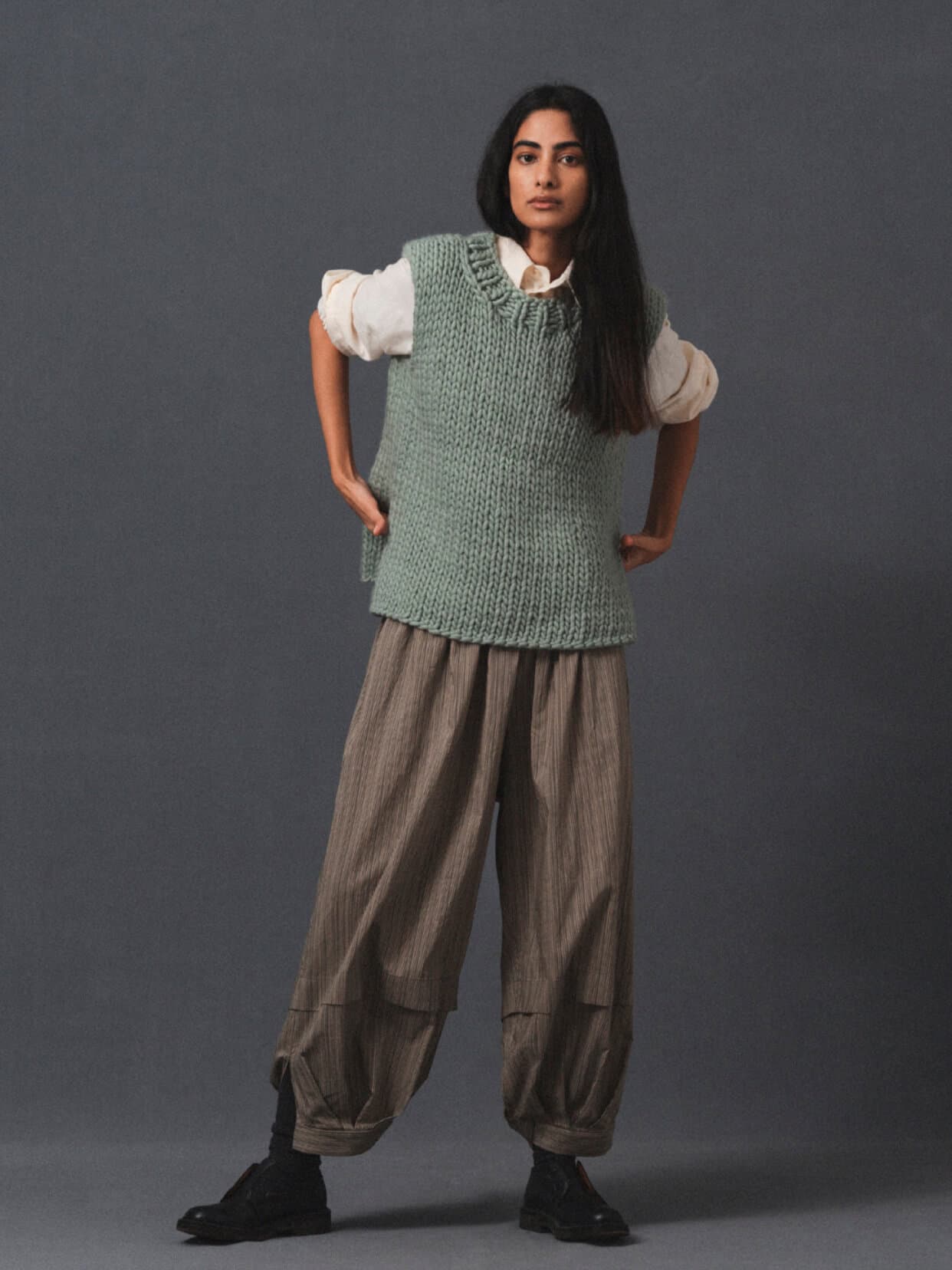
Toogood 019 Collection (2023) The Mountaineer Jumper
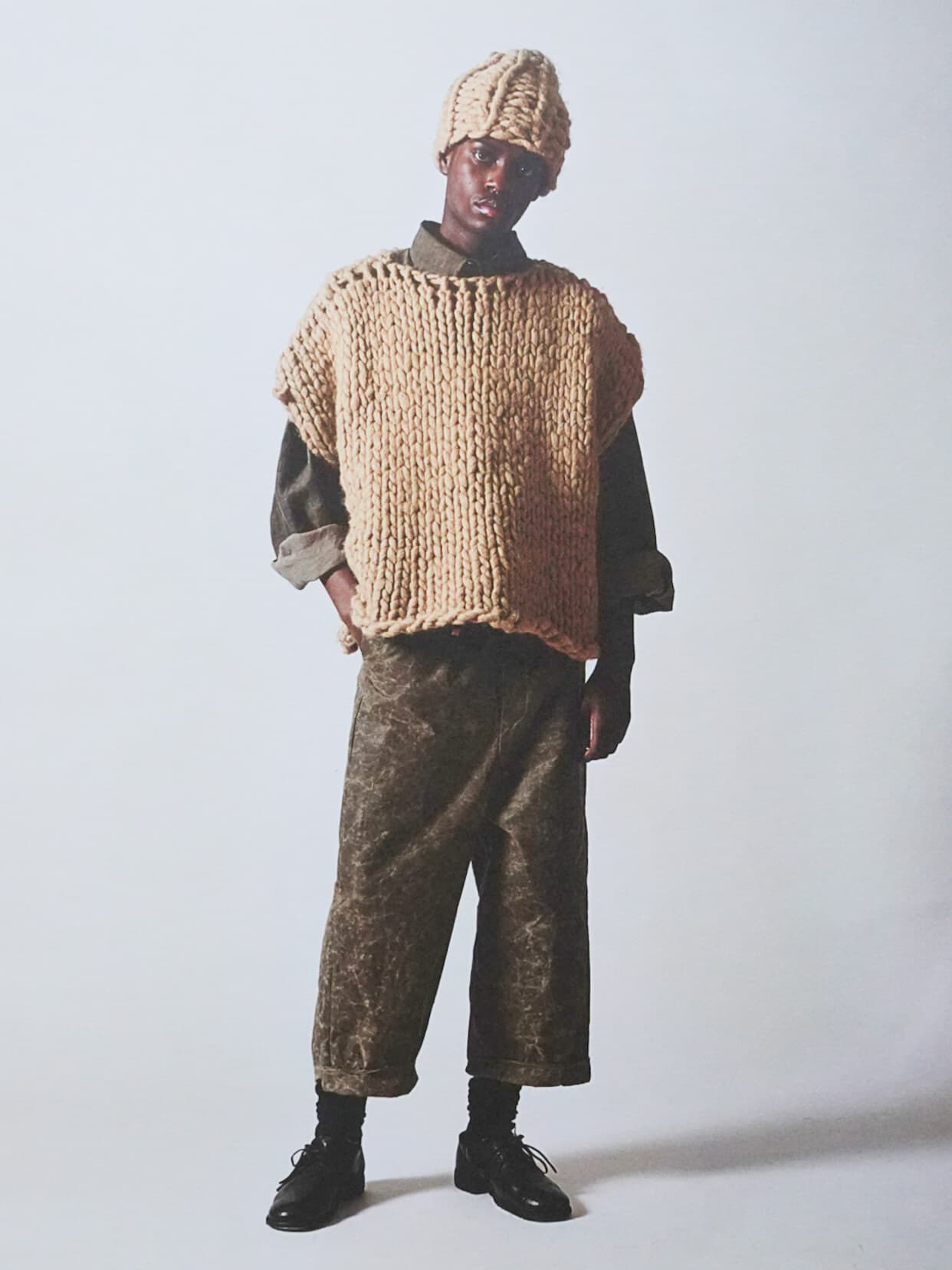
Toogood 003 Collection (2015) The Forester Hat and Jumper
Q2
There is a style in 019 collection that we’re very interested about – The Typesetter. Can you use this as an example to show us the connection between the trade / uniform and the final design.
The Typesetter trade is a beautifully graphic trade. Historically they composed every word by hand for every page on a letterpress. It’s a trade that requires meticulous focus, and precision. I decided it naturally needed to be apron based but with a sharpness and graphic finish. The panel that sits on top of the main body of the Shirt or Dress emulates this apron – somewhere the typesetter would have marked with the inks like an apron, and then removed at the end of the day. The panel can be removed with cuff-link like buttons – either partially or fully. For the Typesetter Dress we used one fabrication for a clean minimal look, and for the Typesetter Shirt we used a contrasting wool panel – adding warmth to the piece, whilst maintaining a cotton base. I am particularly fond of this piece – it reminds me a little of old fencing uniforms too, but with the modernity and fit of an oversized shirt. I have both the shirt and dress on my own personal order, as I feel it’s a key piece for Collection 019.
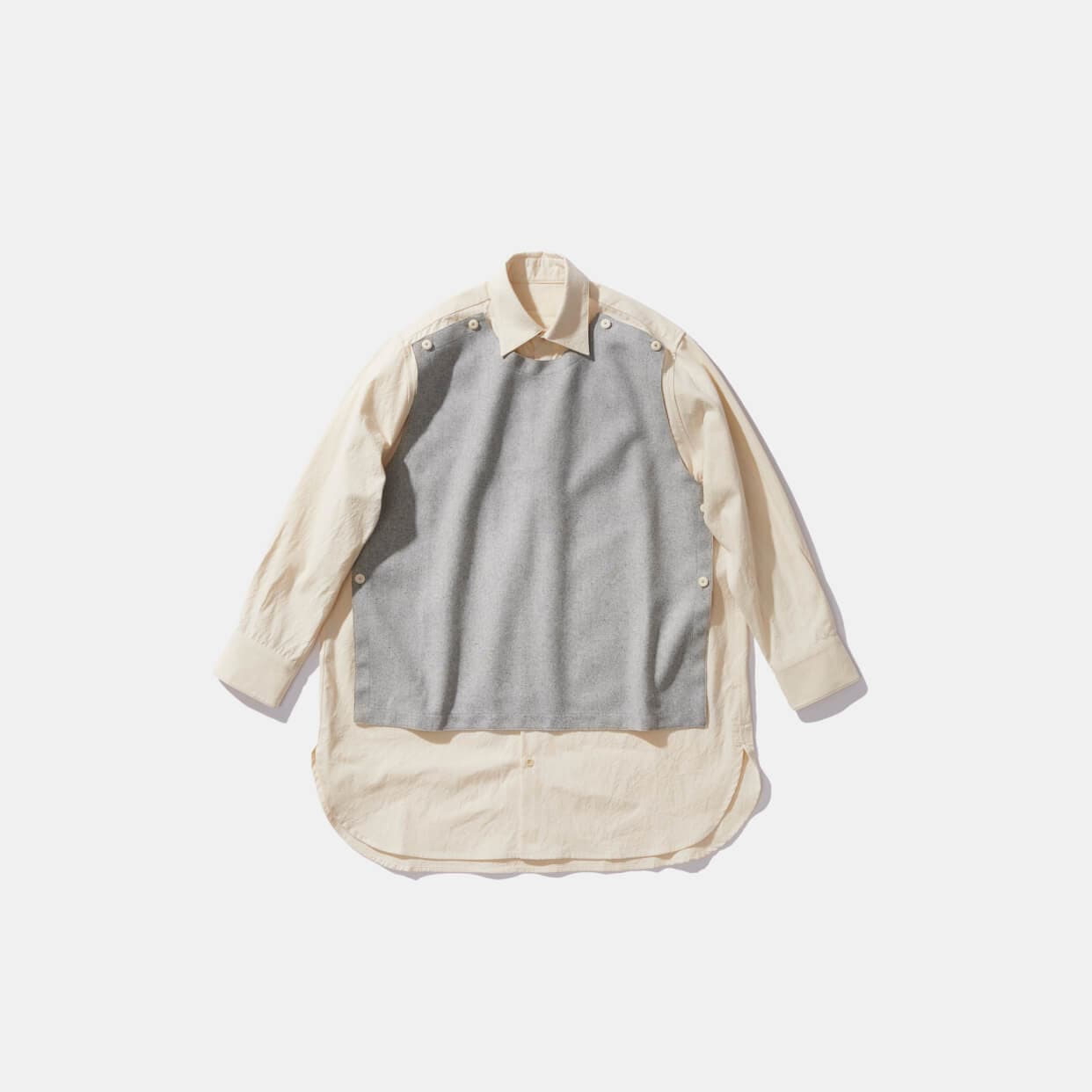
Toogood 019 Collection (2023) Typesetter Shirt
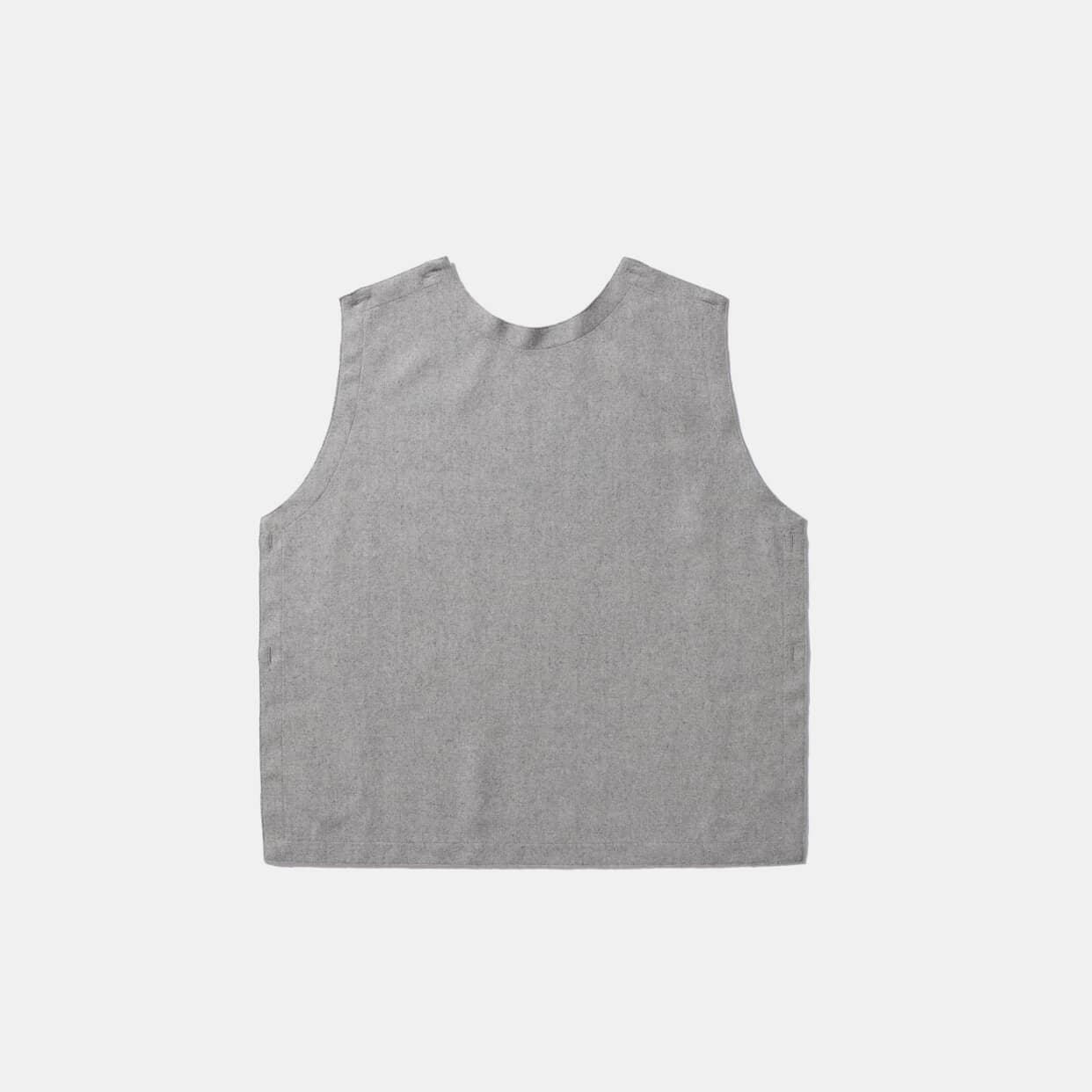
Toogood 019 Collection (2023) Typesetter Shirt
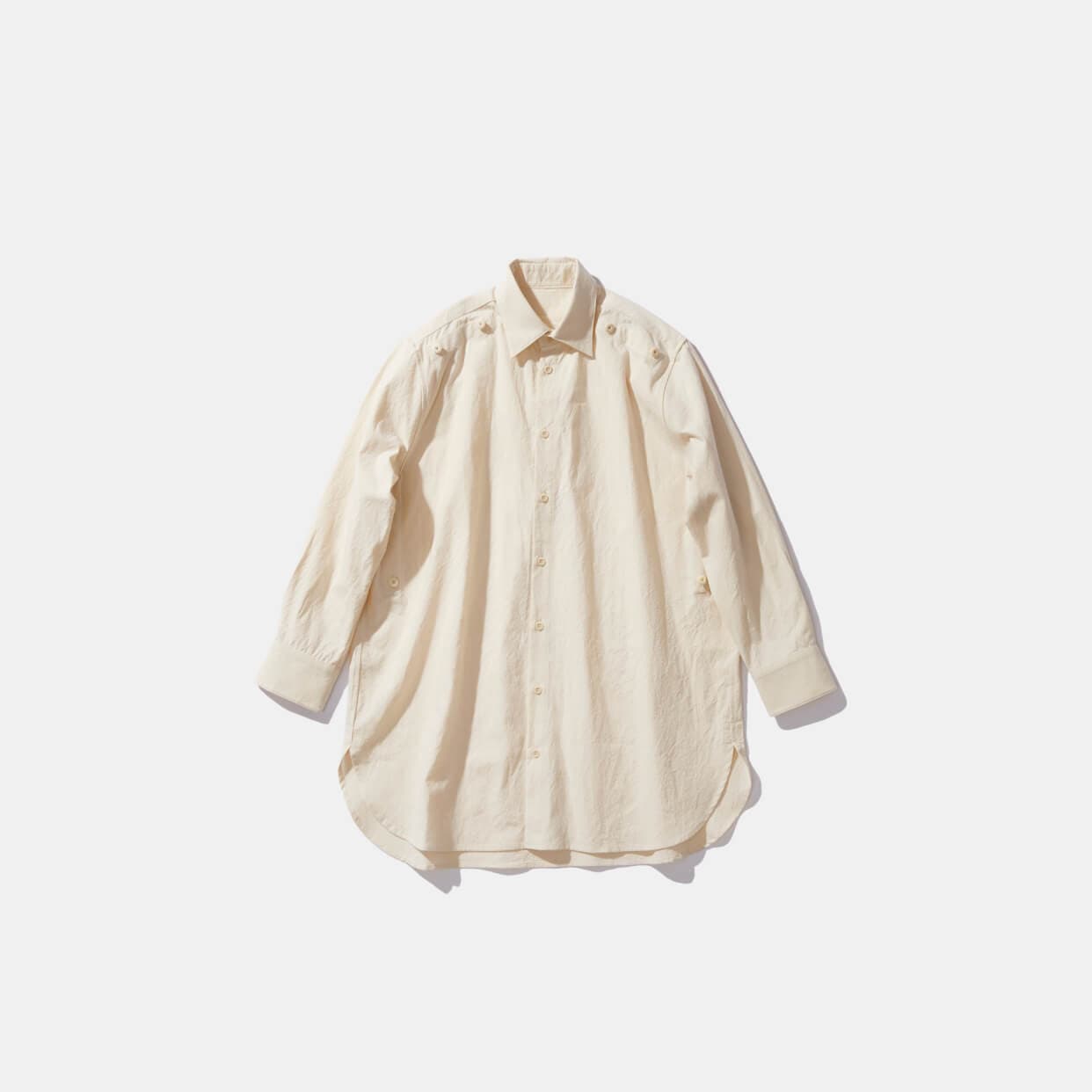
Toogood 019 Collection (2023) Typesetter Shirt
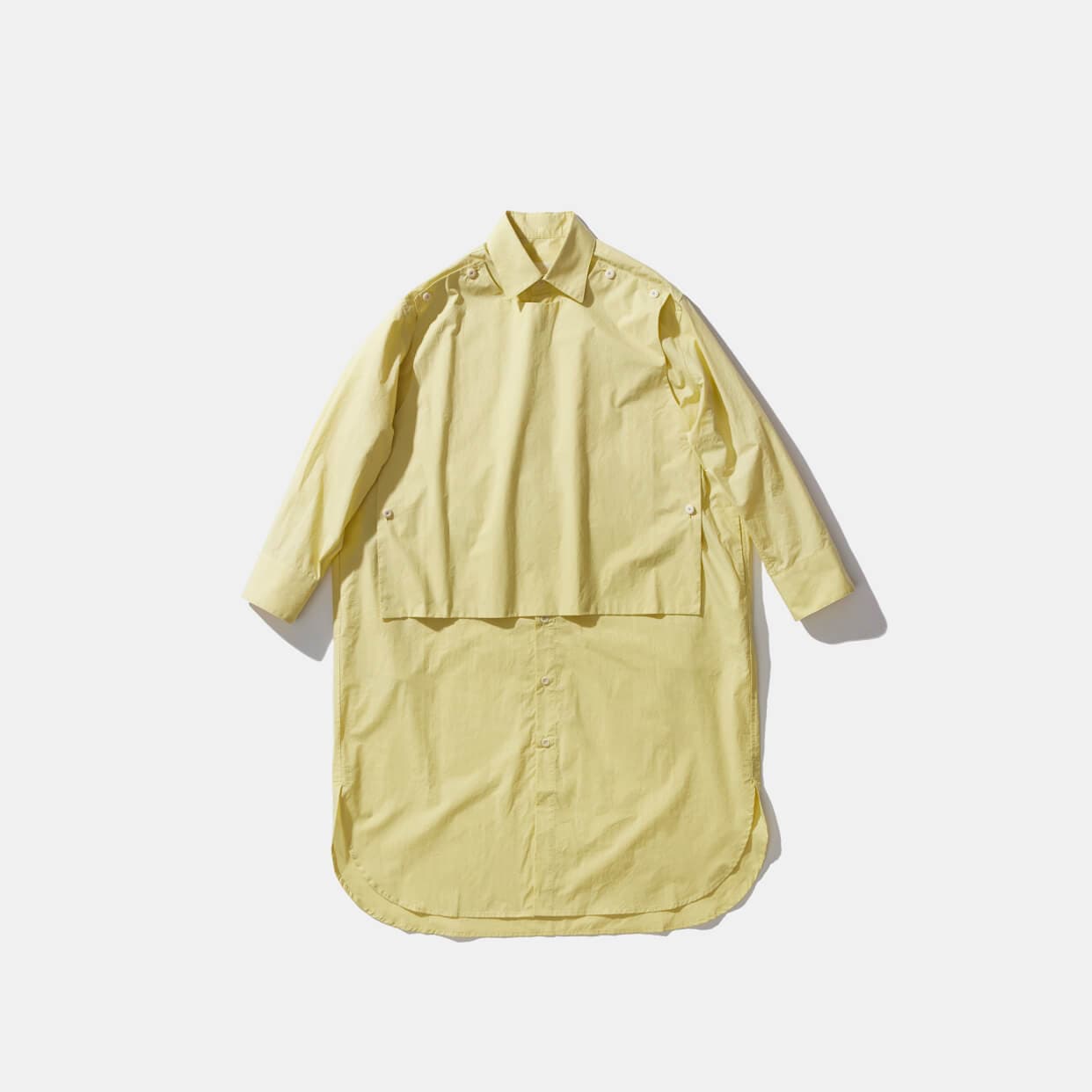
Toogood 019 Collection (2023) Typesetter Dress
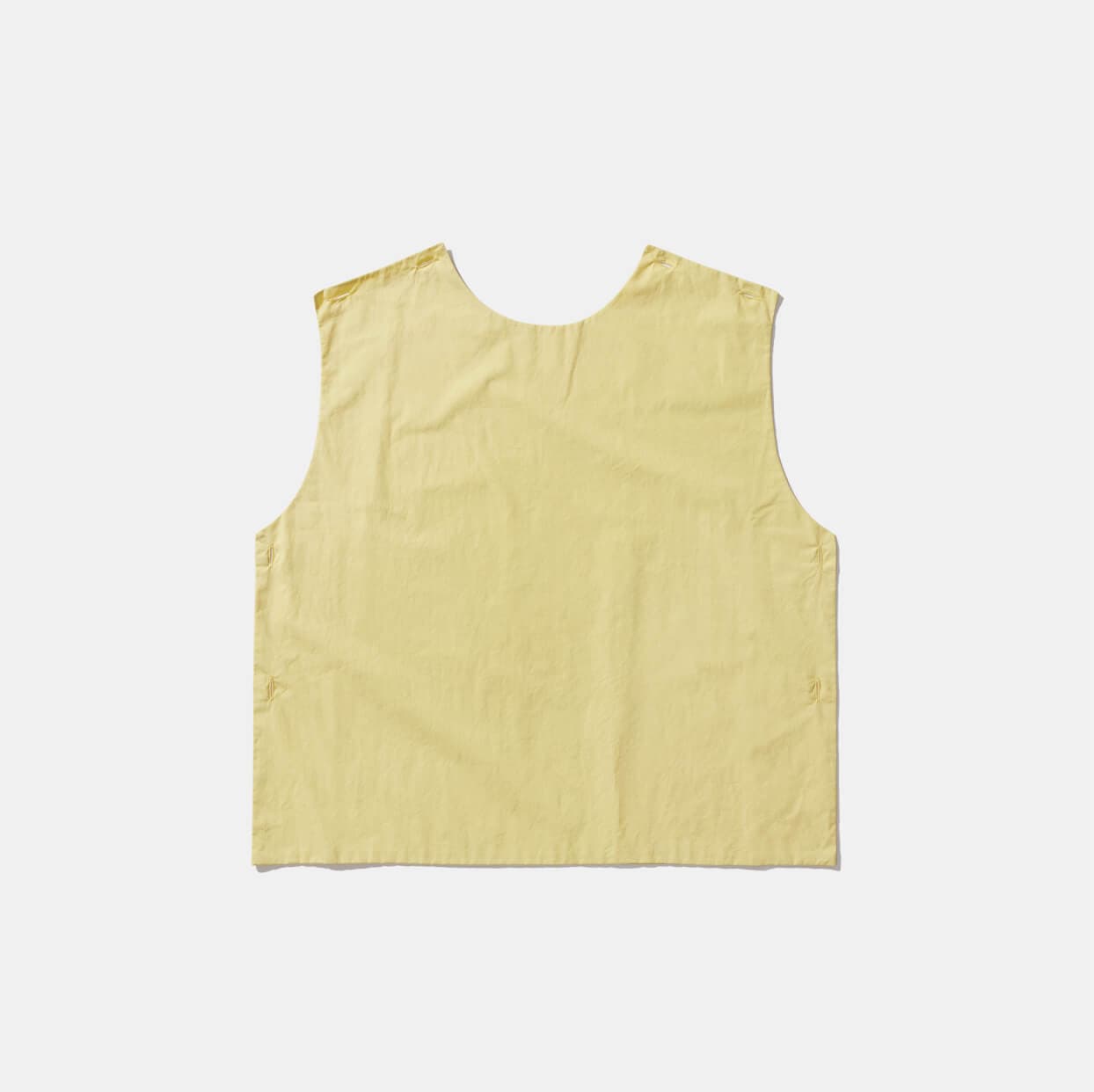
Toogood 019 Collection (2023) Typesetter Dress
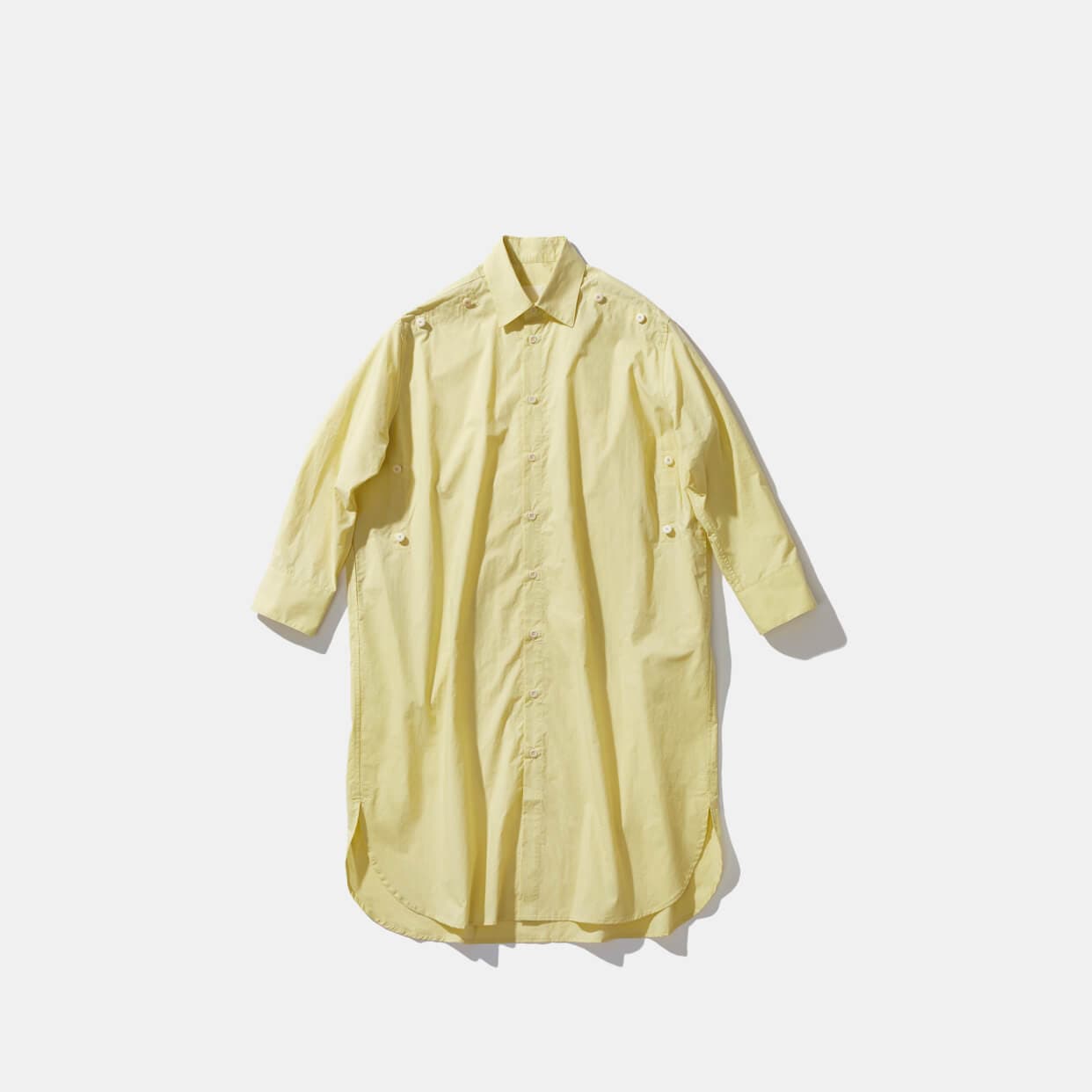
Toogood 019 Collection (2023) Typesetter Dress
This collection has been an important milestone also for us to look back at the beginning of Toogood and see where we are now.
Q3
We as wearers are having a relationship with the clothes we wear, do you agree?
I very much agree with that statement. As a wearer we go on a journey with clothes – ideally they last forever and become firm friends within your wardrobe. Our consistency with trades or shapes (e.g. The Photographer / The Baker) allows the wearer to see those same shapes return each season, just in new fabrications. The clothes somehow take on a strong character and therefore become recognizable and comforting to the wearer. Some of the pieces we have the strongest relationship to are in Denim. Being one of the first work-wear fabrics, it has its own iconic status – and I would suggest within many wardrobes, we all have those piles of jeans that have been there for many years. Some years ago, working with our key shapes, we experimented with British Denim that was woven in Lancashire, a 14oz selvedge denim. These pieces (like much of our early work) were beautifully crafted, however too heavy and very expensive. We have since worked with our denim supplier in Portugal to find a beautifully robust but malleable 13oz Organic Denim that is appropriate for our shapes; able to hold the easy waist elastication on some pieces, whilst also enhancing their sculptural shapes. Our Denim comes in Raw and Indigo and is a perfect balance between an easier jean that is comfortable and still has the clear identity of a Toogood piece. When you receive these pieces, they’re unwashed and we like them to remain as unwashed as possible through their lifespan. As a fabrication, good denim will evolve and patina as its worn and moving to the body of the wearer. It also won’t take forever to soften – they quickly soften as you wear them, but with the density of the weave, they hold their original shape. My denim pieces are staples in my wardrobe.
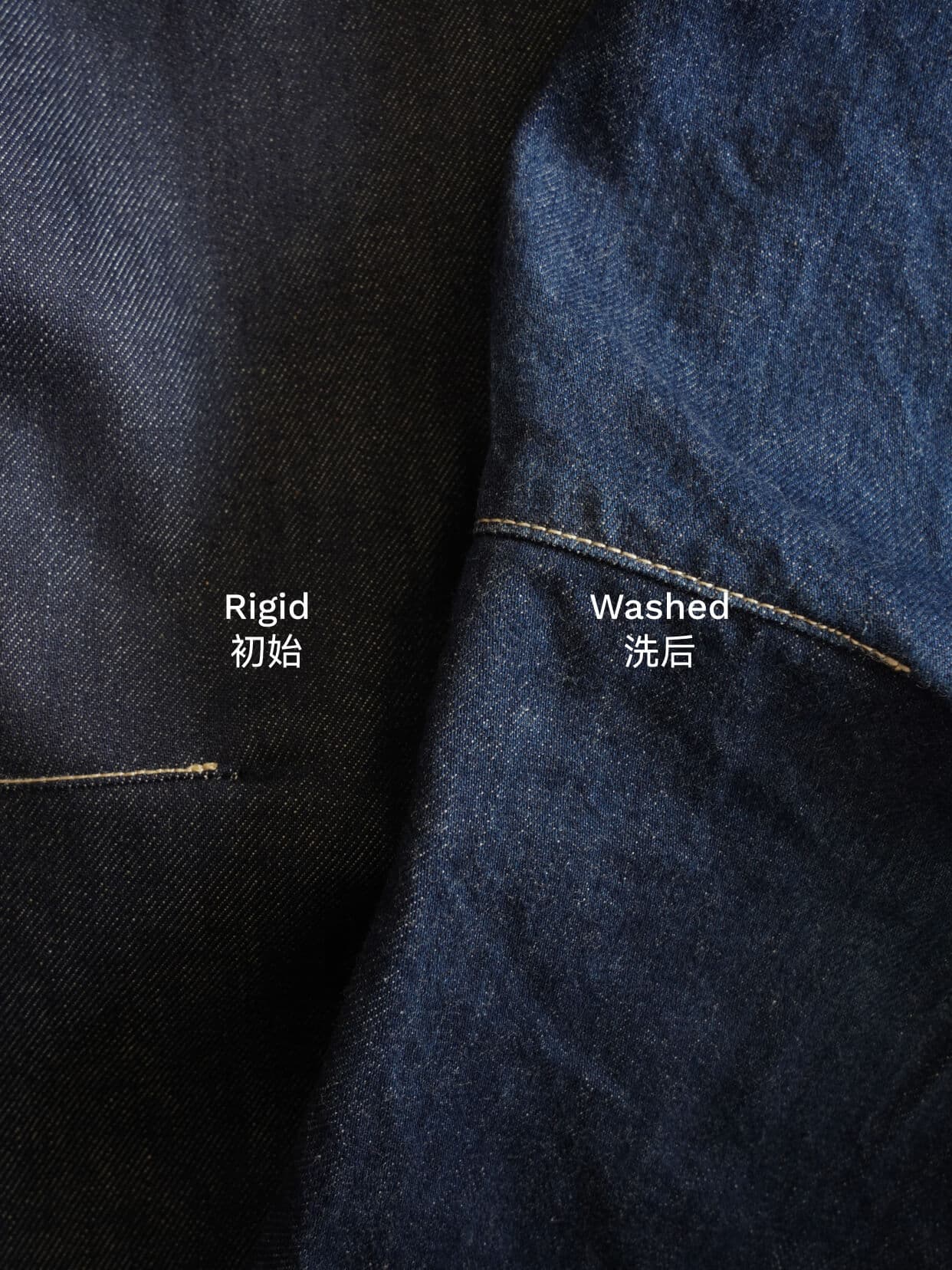
Toogood 019 Collection (2023) The Carpenter Jacket The Skipper Jean
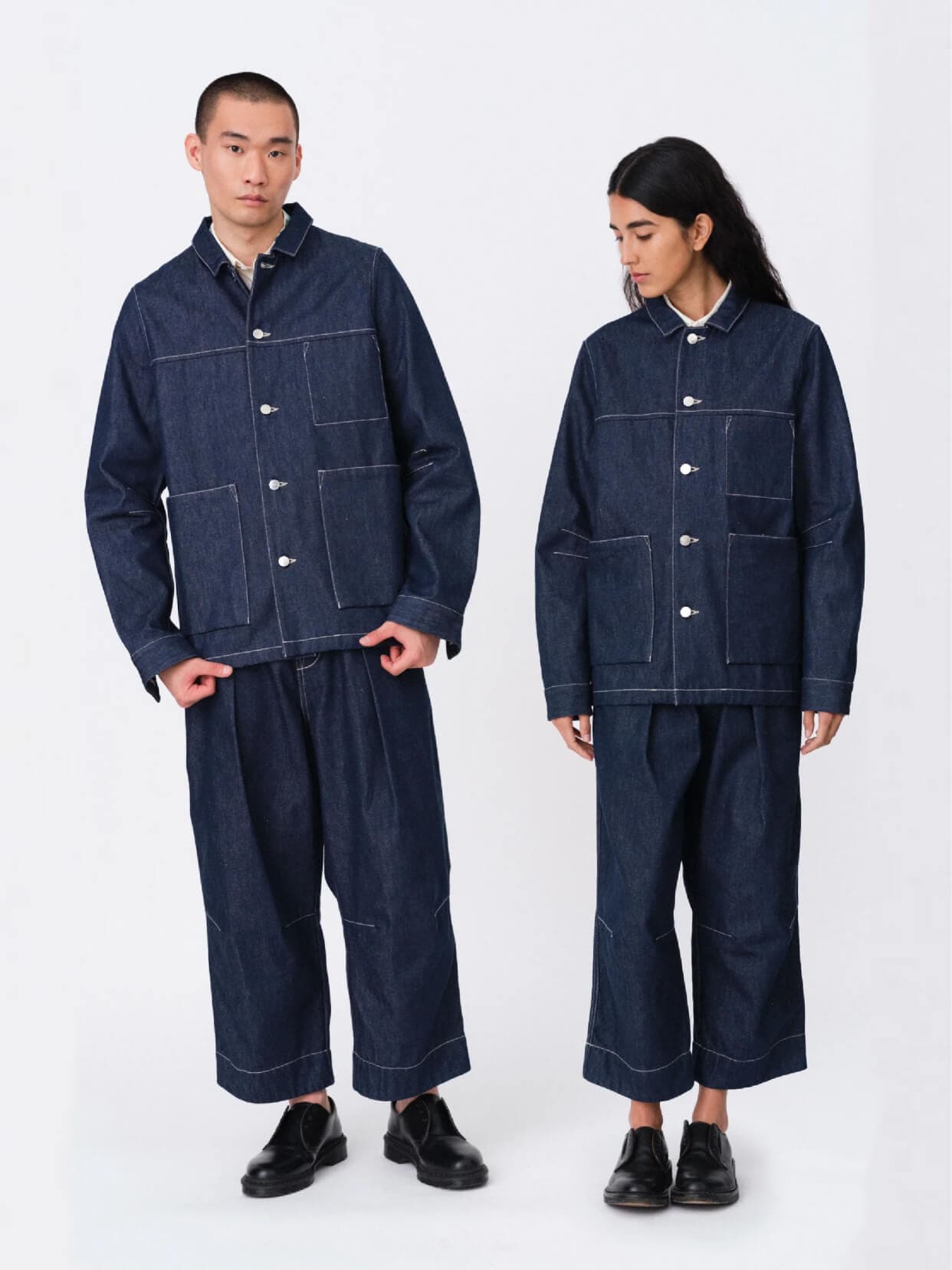
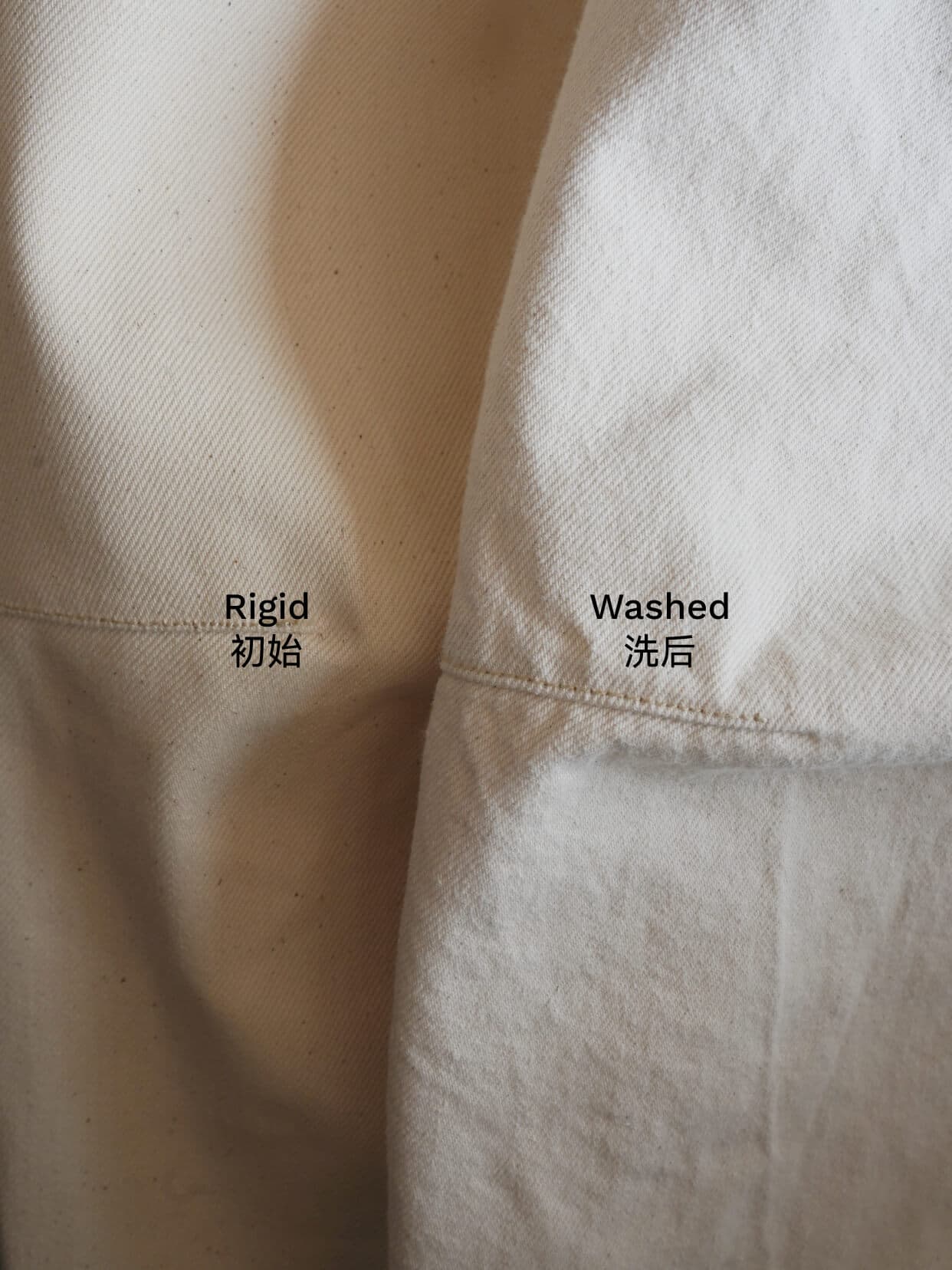
Toogood 019 Collection (2023) The Carpenter Jacket The Skipper Jean
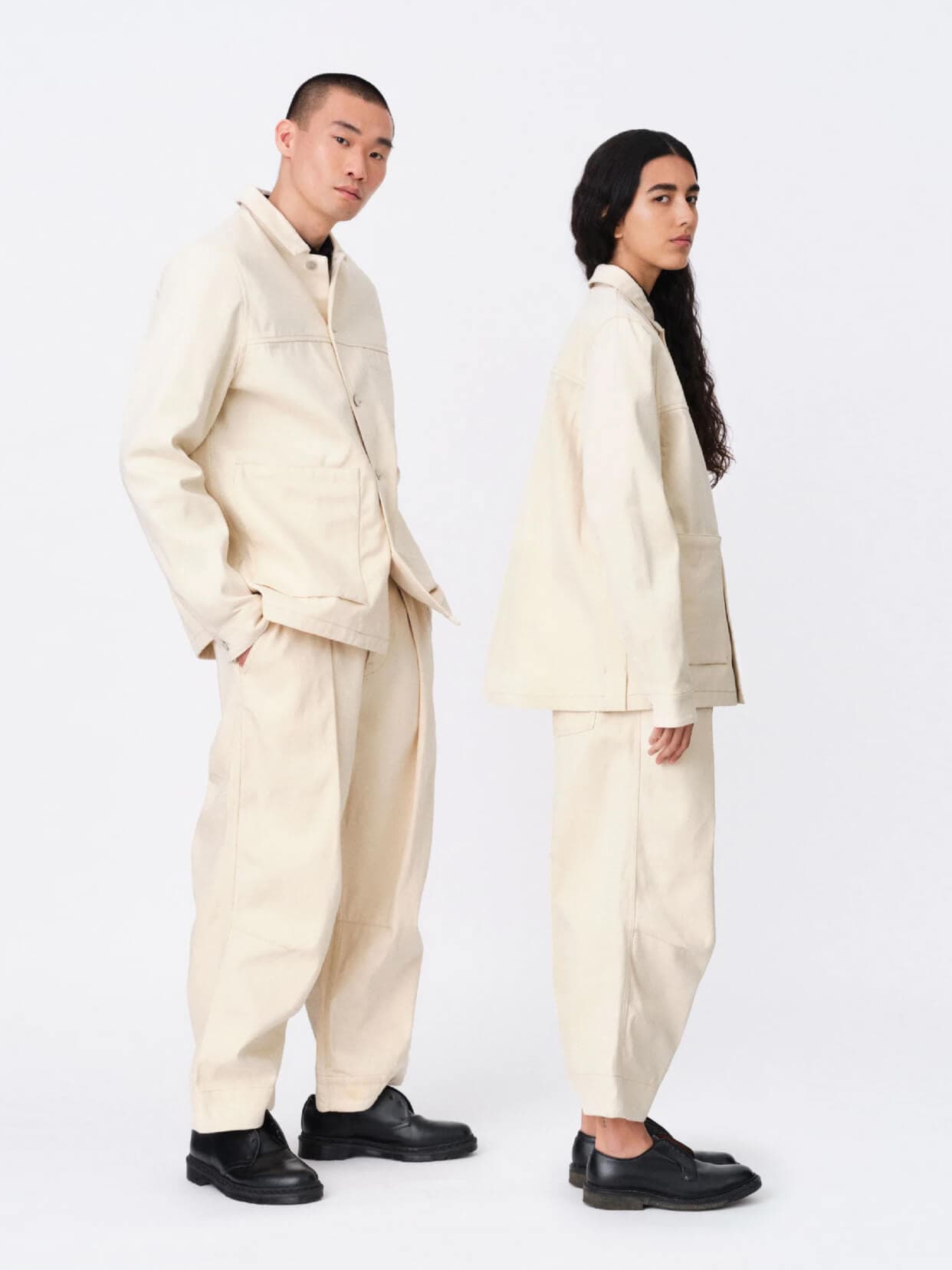
Q4
A lot of people think we sell unisex clothes at FRAW, but we’re not, we sell products that are well designed/well made for women. But “made for women” does not mean it has to be slim and sexy, we have different body shapes / proportions that’s all. How do you position men’s collection and women’s collection? What are the key differences for you when you design menswear and womenswear?
It’s a really interesting question. I generally have muses in my head, whether that be my sister, or my husband, I try and think of those characters and what they would like to wear, and how they would wear it. I will always start with either a male or female size, that will initially define who my primary wearer is. Often if it’s a successful piece, it means that both men and women want to wear it. I have also made pieces with a male focus, and then when a female has tried it on, the proportions and fit have been more desirable for a female form. I strongly feel there are women that don’t wish to dress in form-hugging garments, however they desire to feel feminine. That balance is one that I’m always trying to find – from a personal level too. I wear dresses, but want them to feel practical, and interesting – I don’t need to show every angle of my body to prove I’m a female. By creating sculptural shapes, whether you’re tall or petite, or have a larger or smaller form, the sculpture should be there to enhance your character and your vison – not the other way around. With Toogood we want the clothes to simply be the platform in which you feel you can do anything, but also provide those garments you never really knew you wanted or needed.
A skirt that’s actually a trouser (The Printer Culotte) – I was really intrigued by the feeling of wearing a trouser, but the ‘look’ of a skirt.. for me it’s a very key piece for Toogood womenswear – enabling the wearer to have an ultimately feminine look but the comfort of a wide trouser. The Typesetter Dress – is fundamentally a men’s shirt – but the proportions of that shirt are key – making you feel small in something oversized, and allowing the sculpture of the piece to take president – not your form.
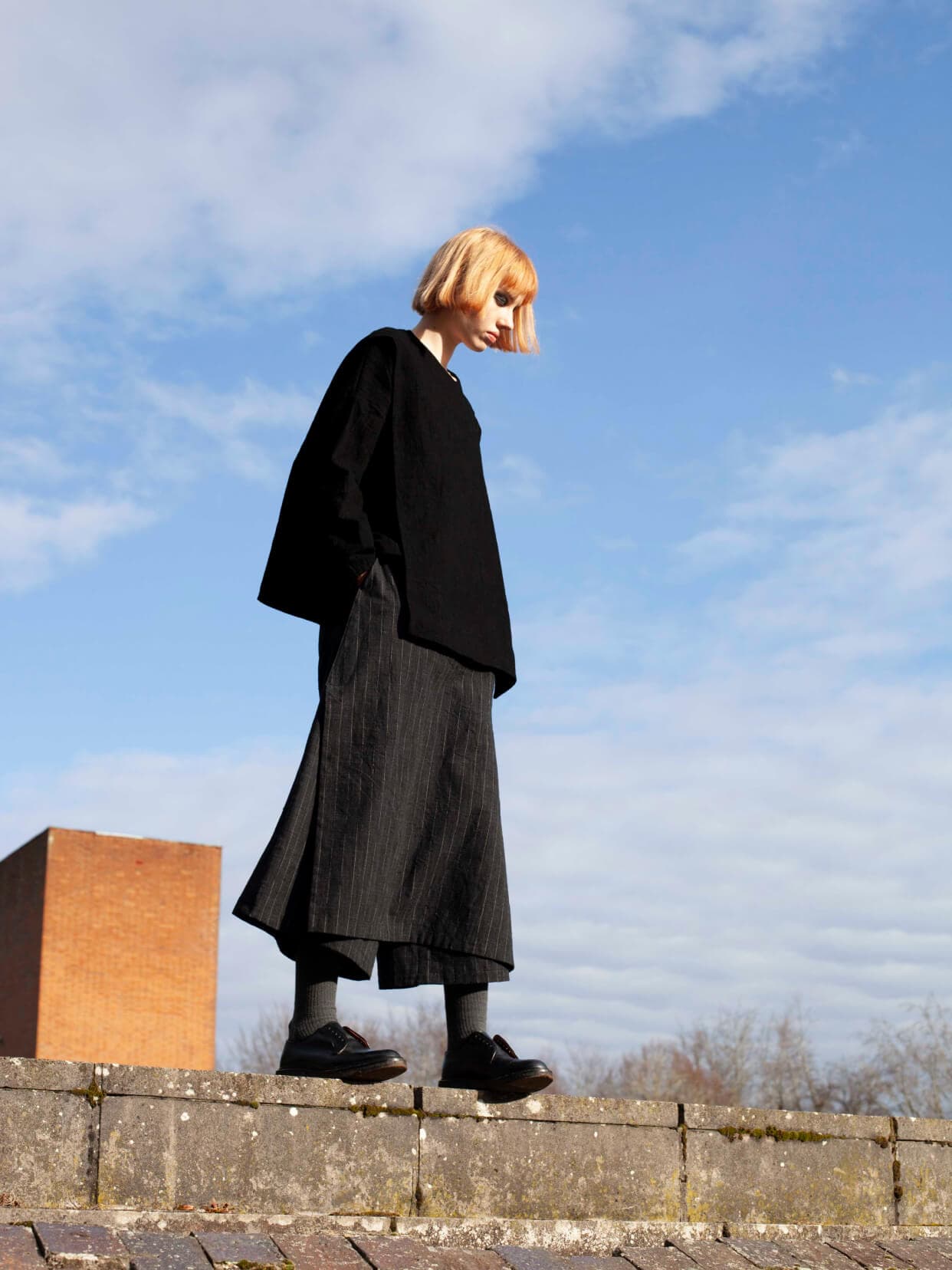
Toogood 019 Collection (2023) The Printer Culotte
The Baker Trouser is a good example of something that started off as Menswear, but soon found itself being graded down for womenswear. This piece has been in every collection since 006. For my husband, he wears them low on his hip, and the hem sits close to the floor. For me, I wear them high on my waist, and the hem hovers at my calf, showing off my ankle and footwear. When a garment can evolve to the customer’s shape and requirements, it proves a successful piece.
How I wear a dress to how Faye wears a dress is entirely different – I will choose larger, more oversized pieces, and wear them big, probably with additional trouser as I’m tall and prefer to layer. She will wear the pieces to fit her smaller frame and usually without the layering otherwise it becomes too heavy. Our mother is 4ft 9in, and I am 5ft 8in. - I have always been fascinated by how height and proportion can entirely change a piece. As we build the collection the different female and male characters that I have in my head are those that are around me, and the ultimate aim is to be able to dress everyone within our range.
Part 2
Behind Toogood
Q5
How big is the team now? What a normal working day looks like in the studio?
Within the studio we have a team of around 20 people. We have just moved from our 3-story house in Shoreditch where we have been for many years to Camden in North London. Our new studio is on one level and so all the different teams who work on Product, Furniture, Interiors and Fashion are now much more integrated. Working alongside each they can more easily share fabrications, inspirations and references. Mood boards will now start to be aligned, so when Faye is building concepts for the teams, we’re able to share similar visions. As a multi-disciplinary studio, our teams are made up of different specialisms – artists and designers work alongside our sales and marketing teams – all of whom are creative heads in their own way. As a group of people we class ourselves as outsiders, (those that feel they maybe conform more to big business or industry are not for us), and as we develop and build the blue-print of our studio it evolves with the team.
15 years ago, Faye started the studio on her kitchen table – developing interiors and product. I joined her 11 years ago to start the fashion side. It has grown organically since then, and many of our team have been with us for a long time.
We have embraced hybrid working, so those that need quiet home space can work from home, and this allows the studio to become a buzzing space of creativity and conversation. I have spent the last few months working remotely from South Africa. Extracting myself from the day-to-day for a few months has been challenging and very rewarding all at the same time. I’ve been able to continue developing sculptural shapes and focusing on providing our team with the bones of the collection. I feel extremely lucky to have had this time and space. I will soon be returning to the UK and feel very excited to continue that work whilst also being at the London studio on a day-to-day basis.
We meet every week to discuss the entire team’s objectives and share any common goals or focuses. As a team it’s very important to cross-pollinate ideas and share processes and developments. We have seen a proposed fashion textile turn into a rug for example or a colour chip handed from the fashion team to the furniture production team. This very important rhythm to the team is integral in the output and approach we have.
We don’t currently have our own store or retail space in London. It’s an aim for us in the future – for someone to be able to experience a space, a mug, a coat… all generated from the same ethos – this would be a dream!
Q6
How do you and Faye work together?
Faye started the studio 15 years ago. Working at that time on sensory environments and furniture. My background is fashion, and at any given moment we would work together on garments for Faye’s events or environments she would build. In 2012 we decided to finally make it official that I would come on-board in the studio and we would develop this additional side of the studio in clothing. Our first project was London Design Festival, 7x7 – 49 oversized coats that were made and hand-painted in our London studio. The coats were inspired by the trades that had been and gone in the Seven Dials area of London. This was the beginning of our concept for Toogood clothing. After this project, Faye set the concept for the first collection and I built the shapes – 9 coats, inspired by trades for Collection 001. Since then, my focus has always been the clothing – designing and pattern cutting, whilst Faye oversees all areas of the studio, from furniture, art and product to the fashion. She is the editor and curator that drives the concept and output of the entire studio.
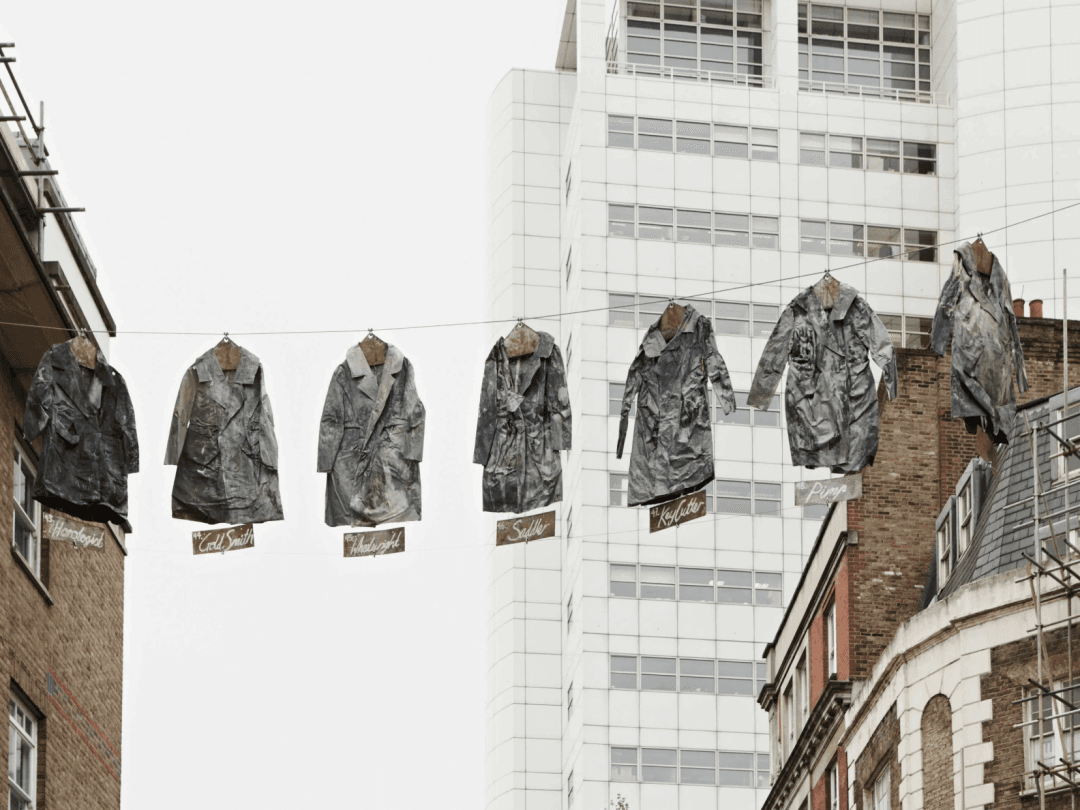
'7 x 7', London Design Festival (2013)
As sisters we work well together, if we don’t see eye-to-eye, we’re able to walk away and come back quickly with no issue. We have deep respect for each other’s trade within the studio – slip streaming our strengths and working quite seamlessly together – often in silence. We have a tone and an approach that is built up from our childhood, resulting in a very common place aesthetically. Since moving to South Africa we have ironically spoken more. Carving out time for zoom calls and having that dedicated space to talk. Faye’s approach is to question boundaries and place her designers in a space where they feel brave and confident to get past the doubt stage of creativity and into a realm where your mind is free to roam. The studio provides that space in abundance – a space for brave creatives to question the daily status quo.
Part 3
Personal Life
Q7
Are you a traveler? How often do you travel and where? Any recommended spots?
Currently, as noted above, I’m in Cape Town in South Africa. My husband was born here, and we recently took the decision to come and spend time here. Our son was about to start school in London, so we took the opportunity to dive out of the metropolis to work remotely and try and answer some burning questions about how we want to live as a family. His work focuses on the future of living, so it has been appropriate to question our own way of living. Having been brought up in the countryside in the UK, both Faye and I have a strong relationship to nature, however I have been in London for 23 years and had been craving change.
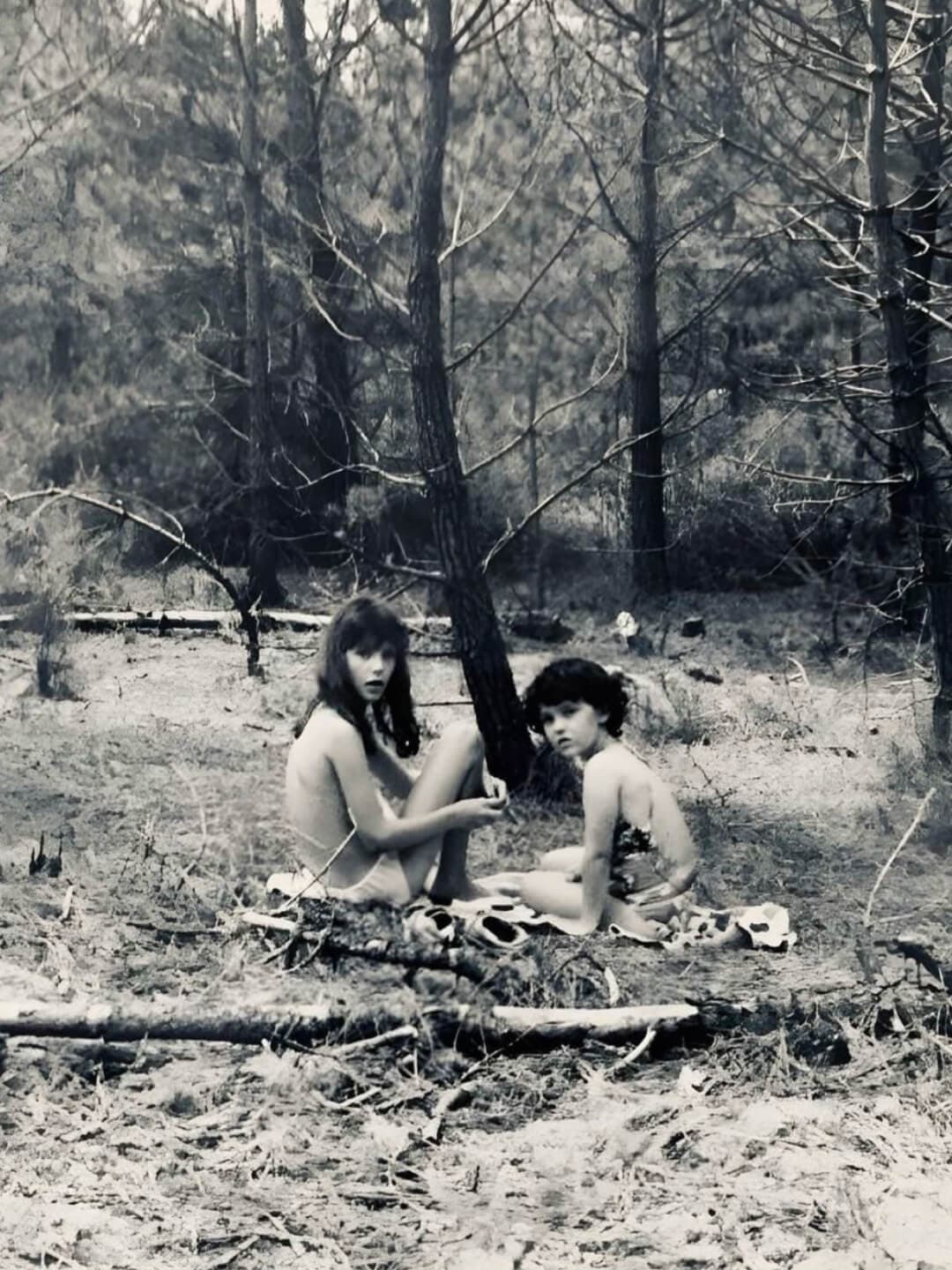
Young Faye (left) and Erica (right) in the forest
Our remote studio looks over the sea, with regular visits from dolphins and soon whales will be using this spot to give birth to their calves. It has been an incredible experience to show this to our son and give him context of something beyond a big city. We have realised the things we have missed, and those things that we can let go of – a very cathartic process that has brought us closer as a family.
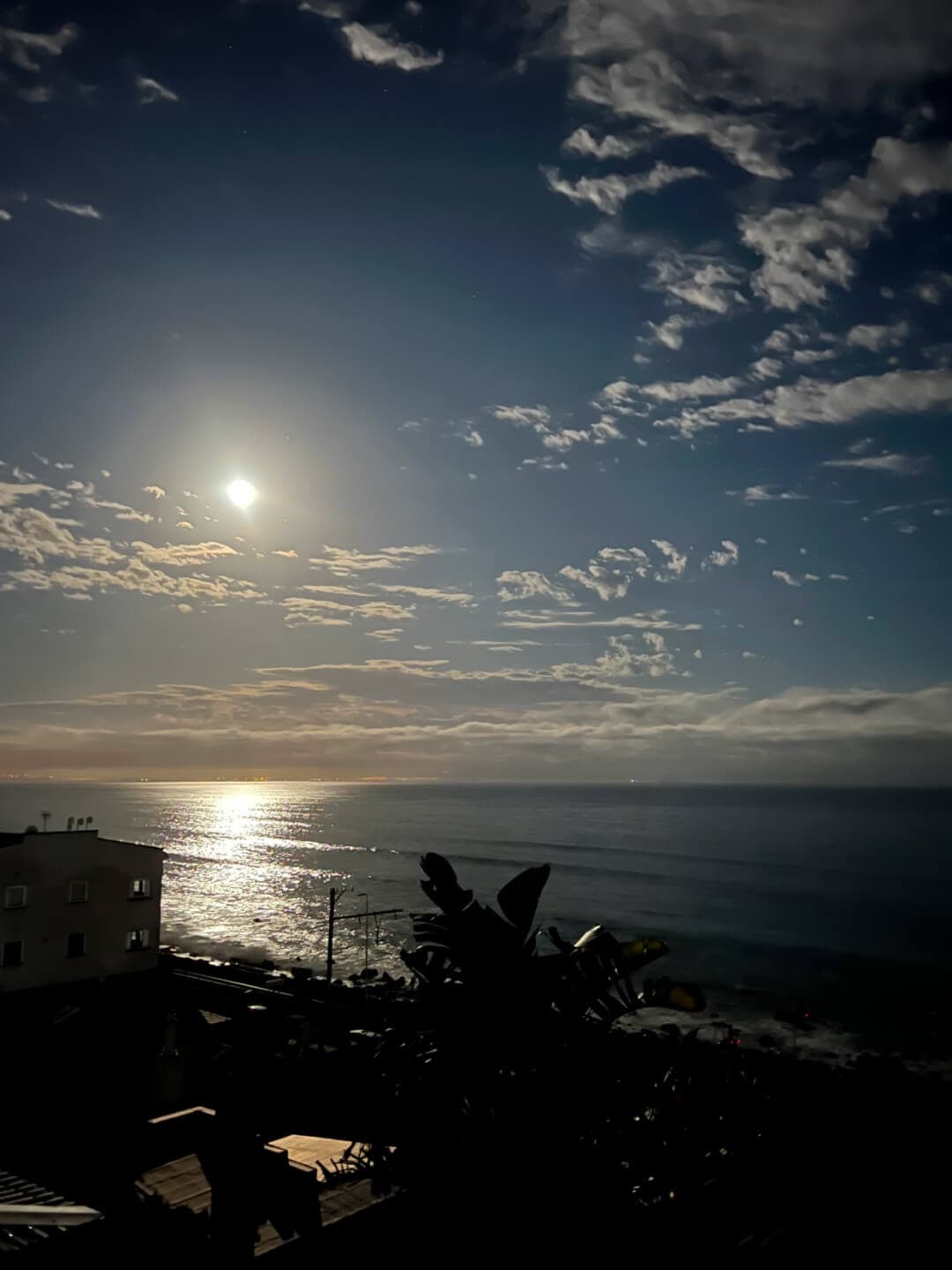
These photos were taken at Erica's home in St. James, Cape Town, overlooking the bay from the terrace.
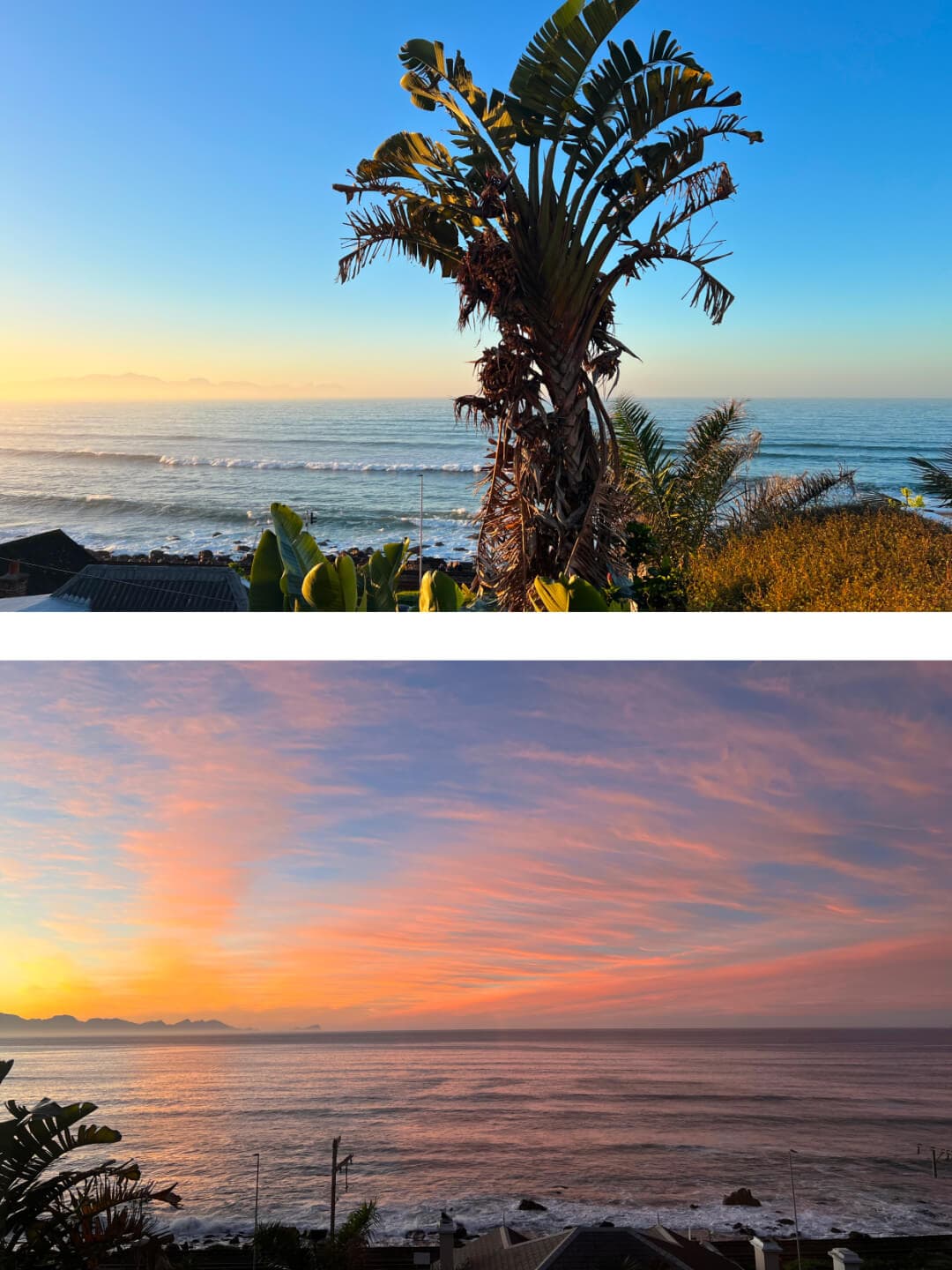
As a city, Cape Town is extraordinary. The culture, history and drive of the people is like nothing I have experienced before. Nature here is the driving force – not the humans – and it constantly reminds you who is in charge. As we move back in the coming weeks to the UK, we return as a changed family. South Africa teaches you patience and gratitude. I highly recommend it.
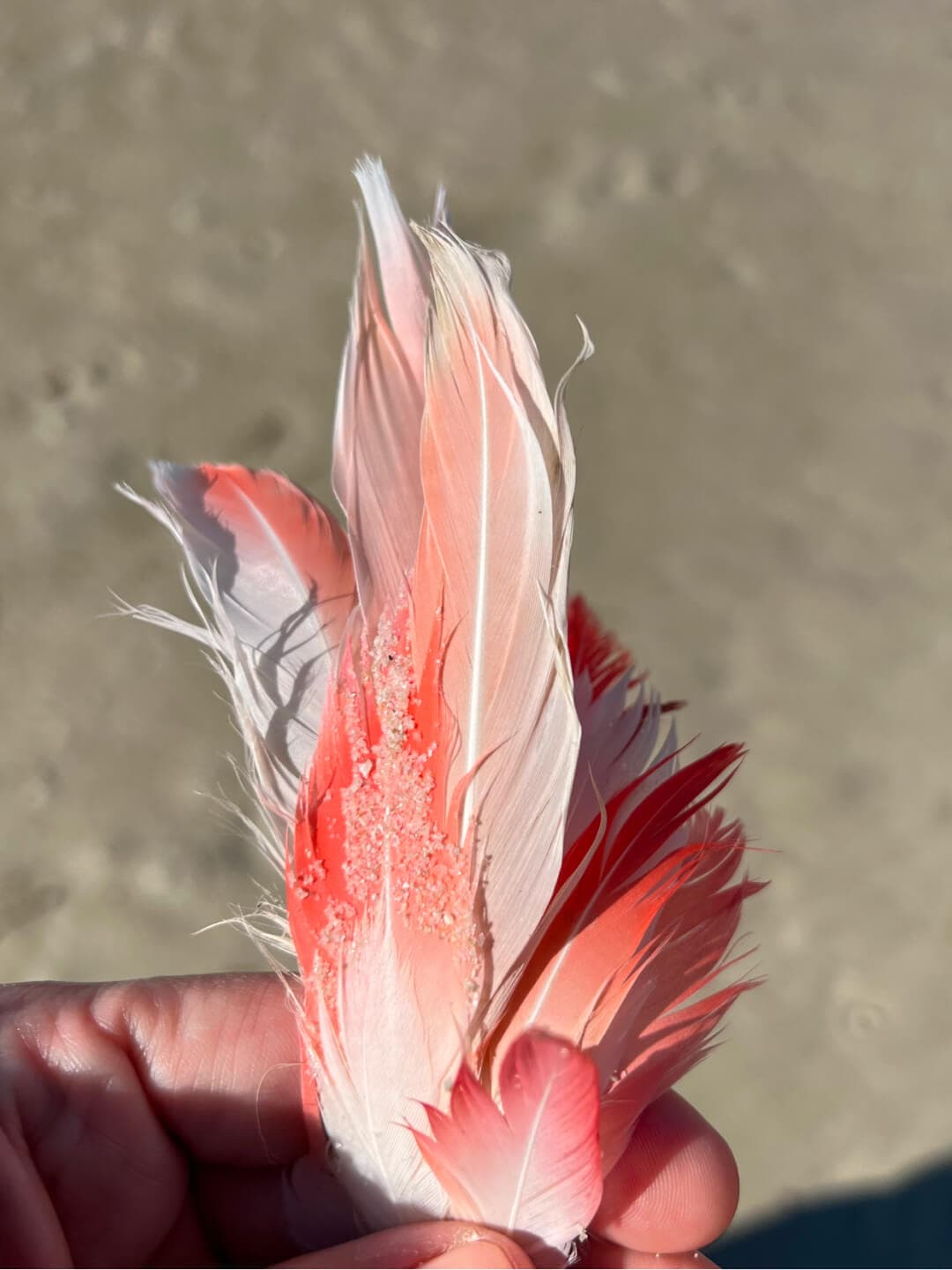
Church Haven, located on the West Coast, is a very special nature reserve with flamingos and an amazing bird sanctuary.
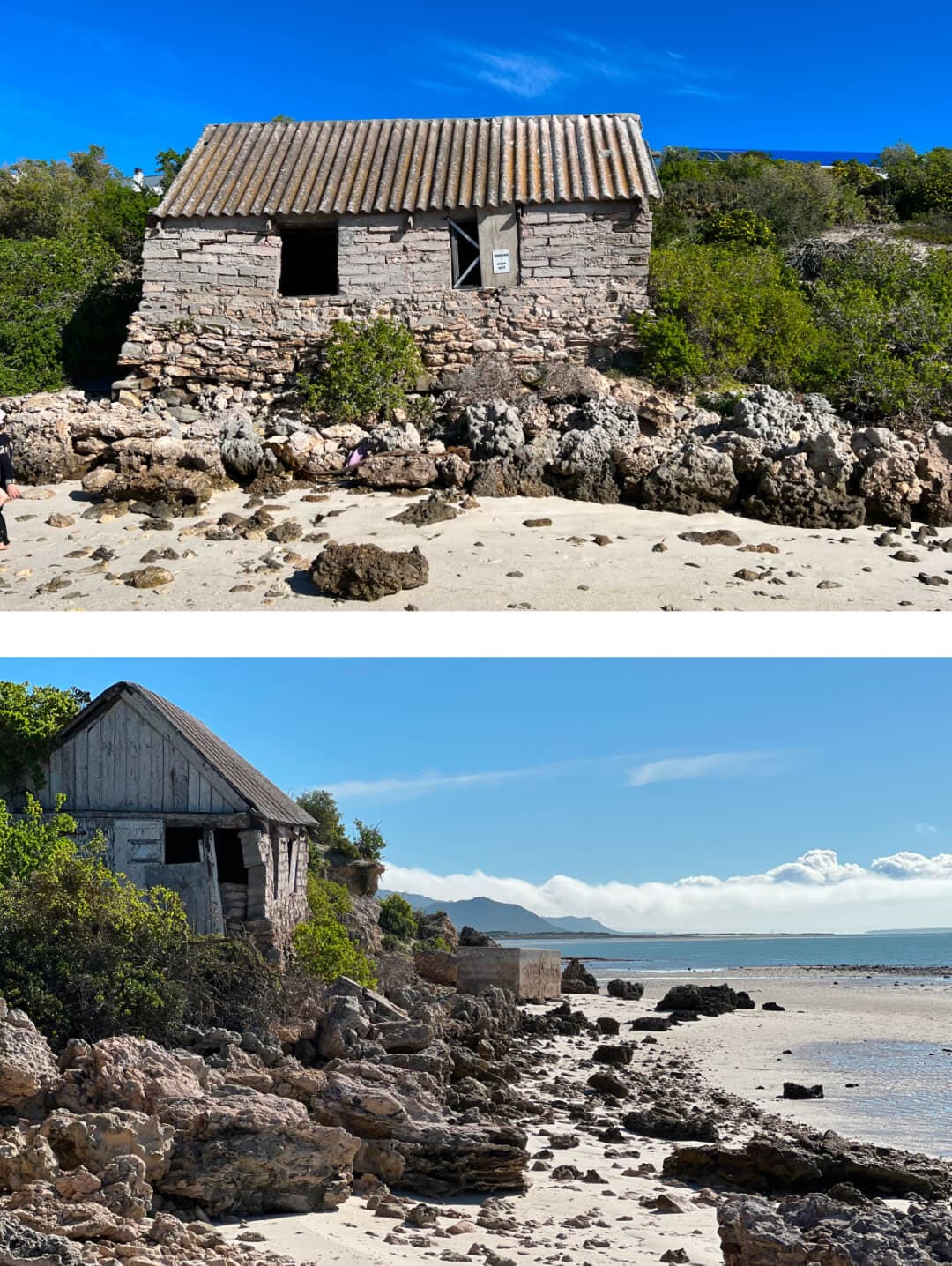
Next on our list to travel is Inverness in California where our good friend Mariah Neilson owns a gallery for her late father JB Blunk’s works, and curates exhibitions of like minds alongside the archives of his very important work.
Q8
A book you’ve been reading lately?
So I always have a stack – that I inevitably fail to get through! But my current untouched pile is:
1. Phyllida Barlow: Collected Lectures, Writings and Interviews.
Before my husband, son and I departed for South Africa, our whole Toogood family went to Roche Court, New Arts Centre in Wiltshire to walk around the beautiful sculptures in the gardens. We stumbled upon the opening of Matt Rudd’s show that day, where Phyllida Barlow was doing a wonderful, thought-provoking talk on Rudd. I filmed it, and later reflected on her beautiful words at this very poignant moment for us surrounded by my family. Only three months later, she sadly passed away. So my next reading journey is to dive deeper into her essays and lectures and to keep listening to her thoughts.
2. Hans Ulrich Obrist: 140 Artists’ Ideas for Planet Earth
I can’t wait to read this. Imagine if Artists took over from the Politicians!
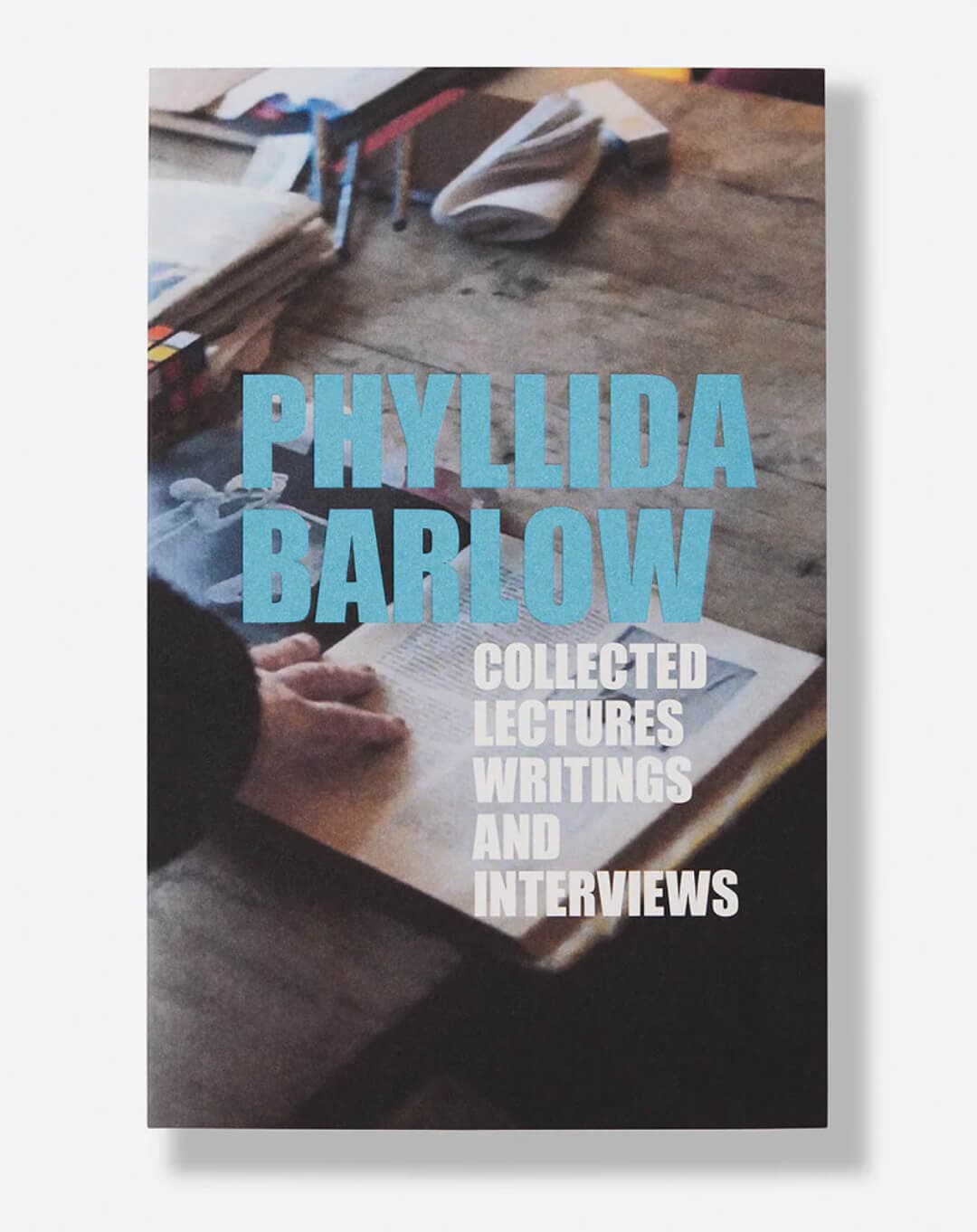
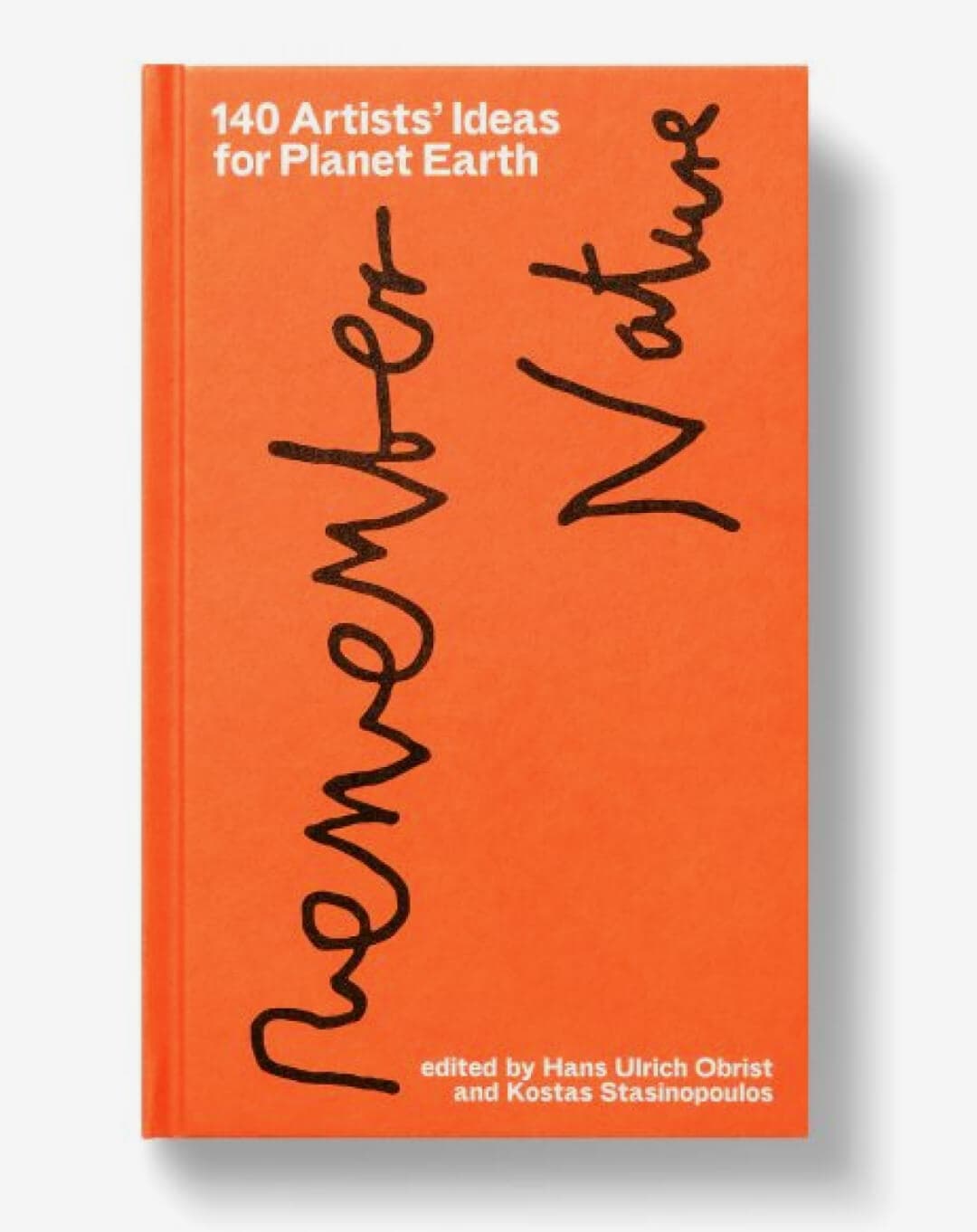
About Toogood
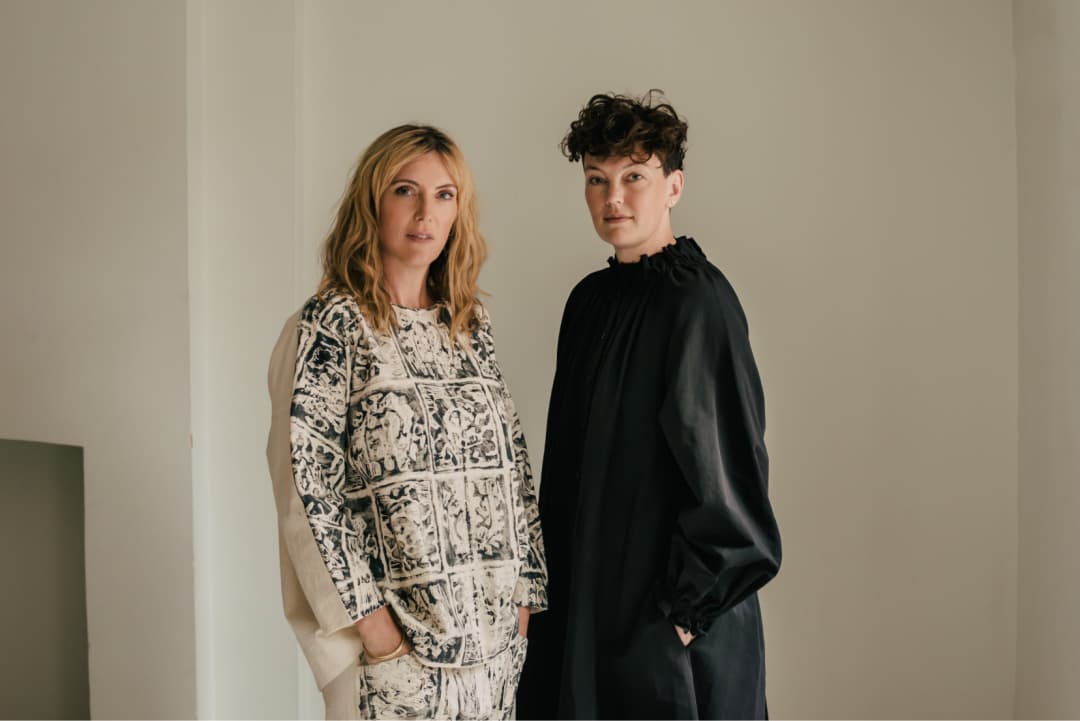
©Photography: Matthew Donaldson
Founded by two sisters, British sculptor and interior designer Faye Toogood and costume designer Erica Toogood, the Toogood clothing brand creates clothing that is both functional and sculptural.
From the beginning, a celebration of the profession has been at the heart of the brand. The names, inspirations and silhouettes of each piece are drawn from traditional trades: The Photographer Jacket, The Baker Trouser and more. It's filled with the unique spirit of the two sisters: Faye's attention to materials and Erica's sculptural shapes. This is how they both define themselves - one as a Tinker and the other as a Tailor.